Building Resilience through Territorial Planning: Water Management Infrastructure and Settlement Design in the Coastal Wetlands of Northern Apulia (Salpia vetus-Salapia) from the Hellenistic Period to Late Antiquity
Abstract
1. Introduction
2. The Study Area and Background
3. Materials and Methods
- -
- Dedicated off-site coring: our project gathered and analyzed sedimentological, palynological, and micropaleontological data coming from a total of 10 drilled boreholes (depth between 9 and 16 m), collected in the area between the sites of Salpia vetus, Salapia, and Salpi (Figure 8). Accelerator Mass Spectrometry 14C dates were obtained from selected charcoals, ostracod shells, and organic sediments (processed by Beta Analytic Radiocarbon Dating—Miami, FL, USA) [13] (in part. pp. 40–41 for details on the calibration methods used). Calibrated ages have been obtained from SAL3, SAM5, SAM6, SAM7, and SAM9 cores, from which datable material was recovered. Apart from the SAM9 core, the relative scarcity of plant remains and organic sediments did not allow the recovery of a consistent chronological sequence for the SAL3, SAM5, SAM6, and SAM7 cores. Despite this, calibrated ages from all dated cores show a good chronological coherence, with an interval spanning from the Late Northgrippian (6206–6104 cal BP = 4256–4154 BCE, SAM9, Figure 8) to the Late Meghalayan (231–164 cal BP = 1719–1786 CE, SAL3, Figure 8). The age-depth model and sedimentation rate of the SAM9 core were built using the Bchron R package (v. 4.7.6), which fits a stochastic linear interpolation in the Compound Poisson–Gamma model. Such multi-proxy paleoenvironmental analyses allowed us to outline better the history of the evolution of this coastal ecosystem over seven millennia.
- -
- Systematic collection, georeferencing, and GIS management of all available historical maps and data on known sites, infrastructural systems, field systems, and historical road networks, with particular reference to the wetland area of Salpia/Salapia/Salpi (the coastal area between the salt pans of Margherita di Savoia, and the courses of the Ofanto and Carapelle Rivers) (Figure 9);
- -
- Aerial photo interpretation: analysis of vertical black-and-white IGM aerial photographs (years 1954–1955 and 1976), AGEA orthophotos from 1997 and 1999; Regione Puglia orthophotos from 2000, 2004, 2005, 2006, 2013, and 2015; oblique aerial photographs taken in the early 2000s, all as part of the systematic aerial reconnaissance campaigns of Northern Puglia conducted by the Department of Humanities of the University of Foggia. Examining this extensive and varied documentation within a GIS framework and considering its quality, resolution, and the years and seasons of capture allowed for the identification of approximately 1700 traces (weedmarks, cropmarks, soilmarks). These traces, primarily located in the hinterlands of Salpia vetus, Salapia, and Salpi, are attributable to settlements, infrastructure, agrarian divisions, and cultivation that no longer relate to the contemporary landscape [25] (Figure 10). With regard to linear features in particular, a series of basic spatial analyses (azimuth calculation, trace extrapolation by orientation classes) were also applied in a GIS environment to verify the possible existence of pre-modern land divisions;
- -
- Systematic field survey: the archaeological field survey, conducted between 2017 and 2019, covered an area of approximately 29 km2. This area, corresponding to the southeastern part of the ager Salapinus, is bordered to the north and east by the inner banks of the coastal lagoon (Saline di Margherita di Savoia), to the west by the Fosso della Pila (a tributary of the Carapelle River), and to the south by the route of the Regio Tratturello Cerignola-Casale della Trinità, which seems to run along the ‘boundary’ between the historical jurisdiction of Salpia-Salapia and the (much larger) one of Canusium (Figure 11);
- -
- Extensive geophysical surveys recovered the urban core, including street grid, and city walls of the Roman city of Salapia and medieval Salpi [26,27,28], as well as suburban and artisanal quarters, the extra-urban road network, and landscape management infrastructure beyond the walls of these towns;
- -
- -
- On-site archaeobotanical analyses of samples recovered from stratigraphically excavated sealed contexts dated by artifact analyses from Salapia and Salpi (predominantly midden deposits, cooking surfaces, floor surfaces, and burial fills); determined anthracological and carpological remains are compared with the diachronic environmental trends reconstructed through analysis of natural sedimentary sequences obtained from off-site coring [31,32,33].
4. Results
4.1. Salpia vetus
4.1.1. A Wrong Choice of Location?
4.1.2. Salubrity and Water Management at Salpia vetus: Challenging Roman Exceptionality
4.1.3. The End of Resilience?
4.2. Roman Salapia (1st c. BCE to Late 5th c. CE): Foundation, Growth, Floruit
4.2.1. Vitruvius on (Re)founding Salapia: Creating a Healthy Site in a Productive Wetland
4.2.2. A Roman Urban Foundation: “Laying Out Lots”
4.2.3. “Making a Harbor of the Lake”
4.2.4. Beyond Production: Salt-Making Infrastructure as Water Management Infrastructure
5. Discussion and Conclusions
Author Contributions
Funding
Data Availability Statement
Acknowledgments
Conflicts of Interest
| 1 | Vitr. 1, 4, 12: Quibus autem insidentes sunt paludes et non habent exitus profluentes neque per flumina neque per fossas, uti Pomptinae, stando putescunt et umores graves et pestilentes in is locis emittunt. Item in Apulia oppidum Salpia vetus, quod Diomedes ab Troia rediens constituit sive, quemadmodum nonnulli scripserunt, Elpias Rhodius, in eiusmodi locis fuerat conlocatum, ex quo incolae quotannis aegrotando laborantes aliquando pervenerunt ad M. Hostilium ab eoque publice petentes impetraverunt, ut his idoneum locum ad moenia transferenda conquireret eligeretque. Tunc is moratus non est, sed statim rationibus doctissime quaesitis secundum mare mercatus est possessionem loco salubri ad senatuque populoque Romano petit, ut liceret transferre oppidum, constituitque moenia et areas divisit nummoque sestertio singulis municipibus mancipio dedit. His confectis lacum aperuit in mare et portum e lacu municipio perfecit. Itaque nunc Salpini quattuor milia passus progressi ab oppido veteri habitant in salubri loco. (“Those places, however, which have stagnant marshes, and lack flowing outlets, whether rivers or by dykes, like the Pontine marshes, by standing become foul and send forth heavy and pestilent moisture. Also in Apulia, the town of Old Salpia, which Diomede returning from Troy established, or, as some have written, Elpias of Rhodes, was situated in such place. As a result, the inhabitants suffered every year from various ailments and they soon came to M. Hostilius, and they beseeched him publicly to seek out and choose an appopriate site for transferring their walls. He did not delay and immediately, after fully ascertaining all the conditions, bought a site in a healthy place, and obtained permission from the senate and Roman people to remove the town. He established the walls and divided the lots and gave formal possession to the individual townsmen for a sesterce each. When this was done, he opened the lake into the sea, and made a harbor out of the lake for the municipality. And so the people of Salpia now dwell on a healthy site at a distance of four miles from the old town”) [1]. |
| 2 | The familiarity of Daunian coastal communities with the practice of fishing is suggested by the stelae of the Archaic period (8th-7th c. BCE) from the area of Sipontum and Salpia, where the depiction of stylised fishes and more articulate fishing scenes (both onshore and offshore) is recurrent: see [40] (nn. 592A, 613A; 615B; 616B; 737B; 742B; 775B). |
| 3 | From Neolithic and until very recent times, hunting activity, although variously regulated, has been an important part of the local economy. Among the fillers of the Daunian s‘ipontine’ and s‘alapine’ stelae, large birds with open wings in flight or marshy birds are abundant, as are hares chased by dogs, while more complex hunting scenes with spears, on foot or on horseback, of deer and other large animals are noteworthy. See [40] (nn. 592A, 613A; 615B; 616B; 737B; 742B; 775B). |
| 4 | The fortifications on the southern side of Salpia vetus have never been excavated, so the dating is based on the analysis of ceramic artifacts found on the surface. It is certain that the oppidum was already fortified during the Hannibalic War (late 3rd century BCE): Livy (27.28) mentions that the city was equipped with walls, towers, and a gate with a sliding shutter system. A precise comparison for the fortifications of Salpia vetus is represented by the defensive system of Arpi, one of the main Daunian cities, located about 8 km northeast of the current city of Foggia. The defensive system enclosed the settlement on only three sides, while the fourth side was protected by the course of the Celone Stream. The structure, built during the 7th century BCE, consisted of a deep moat, 15 m wide, followed on the inside by an embankment on which a wall of raw clay was erected. Between the 5th and 4th centuries BCE, the fortifications underwent renovations. See [44] (pp. 931–951). |
| 5 | This source registers impressions and perspectives of the primary architect of the 18th c. saltpans in the Salpi Lagoon, Luigi Vanvitelli, via his ample correspondence [78]. |
| 6 | Although originally thought to be connected to the salty character of the pools [77], p. 79), recent research has made plain that anopheles mosquitos can breed in both salty and freshwater. The lack of movement in these pools likely encouraged heightened propagation. All species currently present in Europe of the anopheles genus will breed in either fresh or brackish water (an. Atroparvus; an. Labranchiae; an. Plumbeus; an. Sacharovi) [79]. |
| 7 | The proposed village of Mattoni has been discovered (and disturbed) by clandestine activity. We systematically resurveyed the site in 2017, and its finds are currently under study [84]. |
| 8 | The authors demonstrate in Eastern Mediterranean ports in Palestine that heavy siltation was prompted by the scale of Roman seaborne trade when compared to previous periods [92]. |
| 9 | Tuck notes the censors at Rome were responsible for maintaining the channel of the Tiber River, which included its cleaning [94]. |
| 10 | Pickel provides a reading of the Roman agronomists that sees efforts to reduce malarial breeding in agricultural field [96]. |
| 11 | The benefits of this forest management might have been realized by the town, as it is at variance with agricultural landscapes from elsewhere in Italy, such as in central Tuscany in the imperial period. This landscape was largely cleared, probably through exploitation of forest resources and to reclaim land for agriculture [100]. Downstream, in Rome, the effects of this clearing were noted in the ancient sources [101]. |
| 12 | Pliny the Elder records the sight of Utica’s salt mounds, visible when approaching by ship to the harbor [103]. The Atisale installation, visible across the lagoon from the site of Salapia is defined by the mountain of salt, left exposed to the elements, before it is cleaned and packaged. The present-day production at Cervia serves as another example. Rainwater will not melt exposed salt, which forms an intractable crust when exposed to the sun. Only water infiltration from below can melt these mountains. One should also note that in early-modern and present-day Cervia, the salt “market” is positioned in town, not in the pans themselves. |
| 13 | Notations of the saccarii salarii, or “porters who transported sacks of salt” might provide indication of how this product was packaged and transported from the mound [104]. |
| 14 | All species of anopheles mosquito currently present in Europe benefit from low to no water flow, and myriad crevices (hollowed out trees and roots, nooks in plant leaves, etc.) to lay their eggs [79]. |
References
- Vitruvius. On Architecture, Volume I: Books 1–5; Edited from the Harleian Manuscript 2767; English translation modified from that of Frank Granger, Loeb Classical Library 251; Harvard University Press: Cambridge, MA, USA, 1955; pp. 44–47. [Google Scholar]
- Oxford Latin Dictionary, Fascicle VII; Glare, P.G.W., Ed.; Oxford University Press: Oxford, UK, 1980. [Google Scholar]
- Brown, K. Global environmental change I: A social turn for resilience? Prog. Hum. Geogr. 2014, 38, 107–117. [Google Scholar] [CrossRef]
- Holling, C.S. Resilience and stability of ecological systems. Annu. Rev. Ecol. Syst. 1973, 4, 1–23. [Google Scholar] [CrossRef]
- Gunderson, L.H.; Holling, C.S. Panarchy: Understanding Transformations in Human and Natural Systems; Island Press: Washington, DC, USA, 2002. [Google Scholar]
- Daems, D.; Vandam, R. Tracing adaptive cycles and resilience strategies within the Sagalassos settlement record, SW Türkiye. Holocene 2024, 09596836241259771. [Google Scholar] [CrossRef]
- Walker, B.; Holling, C.S.; Carpenter, S.R.; Kinzig, A. Resilience, adaptability and transformability in social–ecological systems. Ecol. Soc. 2004, 9, 5. [Google Scholar] [CrossRef]
- Davis, D.S. Past, present, and future of complex systems theory in archaeology. J. Archaeol. Res. 2023, 1–48. [Google Scholar] [CrossRef]
- Bradtmöller, M.; Grimm, S.; Riel-Salvatore, J. Resilience theory in archaeological practice—An annotated review. Quat. Int. 2017, 446, 3–16. [Google Scholar] [CrossRef]
- Van de Noort, R. Climate Change Archaeology: Building Resilience from Research in the World’s Coastal Wetlands; Oxford University Press: Oxford, UK, 2013. [Google Scholar]
- Walsh, K.; Attema, P.; de Haas, T. The Pontine Marshes (Central Italy): A case study in wetland historical ecology. Babesch 2014, 89, 27–46. [Google Scholar]
- Caldara, M.; Simone, O. L’Ambiente Fisico nell’area dell’Insediamento di Coppa Nevigata. In Coppa Nevigata e L’area Umida alla Foce del Candelaro Durante l’età del Bronzo; Cazzella, A., Moscoloni, M., Recchia, G., Eds.; Grenzi Editore: Foggia, Italy, 2013. [Google Scholar]
- Susini, D.; Vignola, C.; Goffredo, R.; Totten, D.M.; Masi, A.; Smedile, A.; De Martini, P.M.; Cinti, F.R.; Sadori, L.; Forti, L.; et al. Holocene palaeoenvironmental nd human settlement evolution in the southern margin of the Salpi lagoon, Tavoliere coastal plain (Apulia, Southern Italy). Quat. Int. 2023, 655, 37–54. [Google Scholar] [CrossRef]
- di Biase, P. Puglia Medievale e Insediamenti Scomparsi. La Vicenda di Salpi; Schena: Fasano, Italia, 1985. [Google Scholar]
- Biblioteca Provinciale De Gemmis—Bari Mss. B/4, vol. 28, fol. 102.
- Biblioteca Provinciale De Gemmis—Bari Mss. B/3, vol. 54, fol. 56.
- Goffredo, R. La Laguna, la Città. In Salapia-Salpi 1. Scavi e Ricerche 2013–2016; De Venuto, G., Goffredo, R., Totten, D.M., Eds.; Edipuglia: Bari, Italia, 2022; pp. 19–34. [Google Scholar]
- Schmiedt, G. Contributo Della Fotointerpretazione alla Ricostruzione Della Situazione Geografico-Topografica degli Insediamenti antichi Scomparsi in Italia; Istituto Geografico Militare: Firenze, Italy, 1964. [Google Scholar]
- Schmiedt, G. Atlante Aerofotografico Delle Sedi Umane in Italia. Parte II: Le Sedi Antiche Scomparse; Istituto Geografico Militare: Firenze, Italy, 1970. [Google Scholar]
- Schmiedt, G. Contributo della fotografia aerea alla ricostruzione della antica laguna compresa fra Siponto e Salapia. ArchStorPugl 1973, 26, 160–172. [Google Scholar]
- Tiné Bertocchi, F. Gli Scavi del 1967–1968 e del 1978–1979. In Salpia Vetus. Archeologia di Una Città Lagunare; Lippolis, E., Gianmatteo, T., Eds.; Osanna Edizioni: Venosa, Italy, 2008; pp. 77–94. [Google Scholar]
- Cazzella, A.; Moscoloni, M.; Recchia, G. Coppa Nevigata e L’area Umida Alla Foce del Candelaro Durante l’età del Bronzo; Grenzi Editore: Foggia, Italy, 2013. [Google Scholar]
- Nava, M.L. I precedenti insediativi: L’area di Cupola-Beccarini. In Siponto Antica; Mazzei, M., Ed.; Grenzi Editore: Foggia, Italy, 1999; pp. 45–69. [Google Scholar]
- Mazzei, M. Siponto Antica; Grenzi Editore: Foggia, Italy, 1999. [Google Scholar]
- Cardone, A.; Volpe, V. Tra Persistenze e Discontinuità: Analisi Spaziali a Salapia-Salpi e nel Suburbio. In Oltre La Convenzione. Pensare, Studiare, Costruire il Paesaggio Vent’anni Dopo; Castiglioni, B., Puttilli, M., Tanca, M., Eds.; Società Studi Geografici: Firenze, Italy, 2021; pp. 1066–1082. [Google Scholar]
- Cerri, L. La Prospezione Magnetica. La Città e il Suburbio. In Salapia-Salpi 1. Scavi e Ricerche 2013–2016; De Venuto, G., Goffredo, R., Totten, D.M., Eds.; Edipuglia: Bari, Italy, 2022; pp. 63–70. [Google Scholar]
- Cerri, L. La Prospezione Magnetica a Salapia-Salpi 2017–2019. In Salapia-Salpi 2: Scavi e Ricerche 2017–2019; Goffredo, R., Totten, D.M., Eds.; Edipuglia: Bari, Italy, in Progress.
- Goffredo, R.; Cardone, A. Salpi in Capitanata. Fonti, dati archeologici, analisi spaziali per la restituzione di un paesaggio urbano sepolto. Archeol. Mediev. 2021, 48, 301–322. [Google Scholar]
- De Venuto, G.; Goffredo, R.; Totten, D.M. (Eds.) Salapia-Salpi 1. Scavi e Ricerche 2013–2016; Edipuglia: Bari, Italy, 2022. [Google Scholar]
- Goffredo, R. Salpi tra Medioevo ed Età moderna. Nascita, sviluppo e scomparsa di una città. Mélanges De L’école Française De Rome-Moyen Âge 2021, 133, 421–465. [Google Scholar] [CrossRef]
- Della Penna, V.; D’Aquino, S.; Totten, D.M.; Goffredo, R.; Fiorentino, G. Paesaggi, Sistemi Agricoli e Alimentazione tra Continuità e Cambiamento. Analisi Archeobotaniche dal Sito di Salapia-Salpi tra Tarda Antichità e Medioevo. In IX Congresso Nazionale di Archeologia Medievale, Alghero 2022; Milanese, M., Ed.; All’insegna del Giglio: Firenze, Italy, 2022; Volume 2, pp. 415–420. [Google Scholar]
- Fiorentino, G.; D’Aquino, S.; Della Penna, V. Dalla Laguna all’Entroterra: Il Contributo dell’Archeobotanica alla Ricostruzione dei Paesaggi e dei Sistemi Agricoli a Salapia tra Tardo Antico e Alto Medioevo. In Salapia-Salpi 1. Scavi e Ricerche 2013–2016; De Venuto, G., Goffredo, R., Totten, D.M., Eds.; Edipuglia: Bari, Italy, 2022; pp. 573–587. [Google Scholar]
- Fiorentino, G.; Della Penna, V.; D’Aquino, S. Paleoambiente e Paesaggi, Sistemi Agricoli e Alimentazione Vegetale a Salapia-Salpi: Continuità e Cambiamento tra Tarda Antichità e Basso Medioevo. In Salapia-Salpi 2. Scavi e Ricerche 2017–2019; Goffredo, R., Totten, D.M., Eds.; Edipuglia: Bari, Italy, in Progress.
- Delano Smith, C. Daunia Vetus. Terra, Vita e Mutamenti Sulle Coste del Tavoliere; Tipografia Laurenziana: Napoli, Italy, 1978. [Google Scholar]
- Lippolis, E. Introduzione. In Salpia Vetus. Archeologia di Una Città Lagunare; Lippolis, E., Gianmatteo, T., Eds.; Osanna Edizioni: Venosa, Italy, 2008; pp. 33–40. [Google Scholar]
- Traina, G. Paludi e Bonifiche del Mondo antico: Saggio di Archeologia Geografica; L’Erma di Bretschneider: Roma, Italy, 1988; p. 93. [Google Scholar]
- D’Ercole, M.C.; Goffredo, R. Entre Cités et Campagnes: Le sel et les Économies Territoriales de l’Apulie, de l’Antiquité au Haut Moyen Âge. In Sel et Société, Tome 2: Santé—Croyances—Économie; Hoet-van Cauwenberghe, C., Masse, A., Prilaux, G., Eds.; XLIIe Colloque International d’HALMA (Lille 2017); Septentrion: Lille, France, 2020; pp. 275–295. [Google Scholar]
- Goffredo, R. Da Salpia Vetus a Salapia: La Città di Età Romana. In Salapia-Salpi 1. Scavi e Ricerche 2013–2016; De Venuto, G., Goffredo, R., Totten, D.M., Eds.; Edipuglia: Bari, Italy, 2022; pp. 618–622. [Google Scholar]
- Goffredo, R.; Totten, D.M.; Fiorentino, G.; Mazzini, I.; Susini, D. Diachronic Human-Wetland Interactions on the Salpi Lagoon (Apulia, Italy): From the Daunian Period to the Early Middle Ages. In Waterscape Archaeology: Multi-scalar Human-Environment Interactions in Coastal Lagoons; Bivolaru, A., Cottica, D., Morhange, C., Eds.; Archeopress: Oxford, UK, in print.
- Nava, M.L. Stele Daunie; Firenze, Italy. 1980; Available online: https://www.cambridge.org/core/journals/journal-of-roman-studies/article/abs/m-l-nava-stele-daunie-i-studi-e-materiali-di-etruscologia-e-antichita-italiche-xviii-florence-sansoni-1980-pp-vi-225-31-illus-incl-2-folding-maps-395-plates/9E3679D91028833C9DF56043E1B6A493 (accessed on 17 September 2024).
- D’Ercole, M.C. Importuosa Italiae Litora. Paysage et Échanges Dans l’Adriatique Méridionale à L’époque Archaïque; CJB: Napoli, Italy, 2002. [Google Scholar]
- Grelle, F. Allevamento Equino, Transumanza e Agricoltura Nella Puglia Romana, Fra Quarto e Primo Secolo a.C. MEFRA 2016, 128.2. Available online: http://journals.openedition.org/mefra/3746 (accessed on 22 June 2016).
- Santagati, E. Paludi e Fortificazioni nelle Fonti Storiografiche: Una Prima Ricognizione. In Limnai. Archeologia delle Paludi e delle Acque Interne; Caliò, L.M., Lepore, G., Raimondi, G., Todaro, S.V., Eds.; Edizioni Quasar: Roma, Italy, 2022; pp. 141–149. [Google Scholar]
- Pouzadoux, C.; Munzi, P.; Santoriello, A.; Amato, A.; Leone, M.; Muntoni, I.M. Vivere ad Arpi: Le Trasformazioni di una Città Daunia tra Alessandro il Molosso e Annibale. In Roma e il Mondo Adriatico dalla Ricerca Archeologica alla Pianificazione del Territorio; Atti del Convegno Internazionale (Macerata 18–20 Maggio 2017), Perna, R., Carmenati, R., Giuliodori, M., Eds.; Edizioni Quasar: Roma, Italy, 2022; II.2; pp. 931–951. [Google Scholar]
- Gros, P. Vitruvio. De Architectura; Einaudi: Torino, Italy, 1997. [Google Scholar]
- Bandelli, G. Considerazioni Storiche sull’Urbanizzazione Cisalpina di Età Repubblicana (283–89 a.C.). In Forme e tempi dell’urbanizzazione nella Cisalpina (II secolo a.C.-I secolo d.C.), Atti delle Giornate di Studio (Torino, 4–6 maggio 2006); Brecciaroli Taborelli, L., Ed.; All’Insegna del Giglio: Firenze, Italy, 2007; pp. 15–28. [Google Scholar]
- Strazzulla, M.J. In paludibus moenia constituta: Problemi urbanistici di Aquileia in età repubblicana alla luce della documentazione archeologica e delle fonti scritte. AAAd 1989, 35, 187–228. [Google Scholar]
- Maselli Scotti, F.; Mandruzzato, L.; Tiussi, C. Primo Impianto Coloniario di Aquileia: L’Area Tra foro e Macellum. In Forme e tempi dell’urbanizzazione nella Cisalpina (II secolo a.C.-I secolo d.C.), Atti delle Giornate di Studio (Torino, 4–6 maggio 2006); Brecciaroli Taborelli, L., Ed.; All’Insegna del Giglio: Firenze, Italy, 2007; pp. 35–40. [Google Scholar]
- Bonetto, J.; Furlan, G.; Ghiotto, A.R.; Missaglia, I. Il Canale Anfora e il centro urbano di Aquileia: Osservazioni cronologiche alla luce di nuovi dati. JAT 2020, XXX, 175–202. [Google Scholar]
- Maggi, P.; Maselli Scotti, F.; Pesavento Mattioli, S.; Zulini, E. (Eds.) Materiali per Aquileia. Lo scavo di Canale Anfora (2004–2005); Edizioni Quasar: Roma, Italy, 2018. [Google Scholar]
- Cresci Marrone, G.; Tirelli, M. Altino Romana: Limites e Liminarità. In Forme e Tempi dell’Urbanizzazione nella Cisalpina (II secolo a.C.-I secolo d.C.); Atti delle Giornate di Studio (Torino, 4–6 maggio 2006), Brecciaroli Taborelli, L., Eds.; All’Insegna del Giglio: Firenze, Italy, 2007; pp. 61–66. [Google Scholar]
- Gelichi, S. Ravenna, ascesa e declino di una capitale. In Ripoll, G., Ed., Sedes regiae (annis 400–800). Mem. De La Real Acad. De Buenas Let. Barc. 2000, 25, 109–134. [Google Scholar]
- On this theme, see Perlgrom, J. The Roman rural exceptionality thesis revisited. Mélanges De L‘école Française De Rome-Antiq. 2018, 130, 69–103. [Google Scholar]
- Alvisi, G. La Viabilità Romana della Daunia; Tipografia del Sud: Bari, Italy, 1970. [Google Scholar]
- Bernard, S.; McConnell, J.; Di Rita, F.; Michelangeli, F.; Magri, D.; Sadori, L.; Masi, A.; Zanchetta, G.; Bini, M.; Celant, A.; et al. An Environmental and Climate History of the Roman Expansion in Italy. J. Interdiscip. Hist. 2023, 54, 1–41. [Google Scholar] [CrossRef]
- Zanchetta, G.; Baneschi, I.; Magny, M.; Sadori, L.; Termine, R.; Bini, M.; Vannière, B.; Desmet, M.; Natali, S.; Luppichini, M.; et al. Insight into summer drought in southern Italy: Palaeohydrological evolution of Lake Pergusa (Sicily) in the last 6700 years. J. Quat. Sci. 2022, 37, 1280–1293. [Google Scholar] [CrossRef]
- Grelle, F.; Silvestrini, M. La Puglia nel Mondo Romano. Storia di Una Periferia. Volume I. Dalle Guerre Sannitiche Alla Guerra Sociale; Edipuglia: Bari, Italy, 2013. [Google Scholar]
- Grelle, F.; Silvestrini, M.; Volpe, G.; Goffredo, R. La Puglia Nel Mondo Romano. Storia di Una Periferia. L’Avvio dell’Organizzazione municipale; Edipuglia: Bari, Italy, 2017. [Google Scholar]
- Sallares, R. Malaria and Rome. A History of Malaria in Ancient Italy; Oxford University Press: Oxford, UK, 2002. [Google Scholar]
- De Venuto, G.; Goffredo, R.; Totten, D.M.; Ciminale, M.; De Mitri, C.; Valenzano, V. Salapia: Storia e Archeologia di Una Città Tra Mare e Laguna. Mélanges De L’école Française De Rome Antiq. 2015, 127, 97–130. Available online: http://mefra.revues.org/2719 (accessed on 17 September 2024). [CrossRef]
- Goffredo, R.; Totten, D.M.; Loprieno, S. Salapia Romana. Salpi Medievale (Ceringnola, FG): Notizie Dagli Scavi 2017. Fold&R J. FastiOnline 2018, 426. Available online: https://www.fastionline.org/docs/FOLDER-it-2018-426.pdf (accessed on 17 September 2024).
- De Venuto, G. L’Area della Conceria dell’Isolato XII. In Salapia-Salpi 1: Scavi e ricerche 2013–2016; De Venuto, G., Goffredo, R., Totten, D.M., Eds.; Edipuglia: Bari, Italy, 2022; pp. 115–140, in particular p. 116. [Google Scholar]
- Kolowski-Ostrow, A.O. The Archaeology of Sanitation in Roman Italy: Toilets, Sewers and Water Systems; UNC Press: Chapel Hill, NC, USA, 2016. [Google Scholar]
- Totten, D.M. The Excavation of Insula XII: Architectural and Archaeological Features North and East of the Domus (Edificio A and Edificio B). In Salapia-Salpi 1: Scavi e ricerche 2013–2016; De Venuto, G., Goffredo, R., Totten, D.M., Eds.; Edipuglia: Bari, Italy, 2022; pp. 173–218. [Google Scholar]
- Crowson, A.; Giles, O.J. The Archaeology of the Vrina Plain: An Assessment. In Roman Butrint: An Assessment; Hansen, I.L., Hodges, R., Eds.; Oxbow Books for the Butrint Foundation: Oxford, UK, 2007; pp. 119–164. [Google Scholar]
- De Santis, V.; Scicchitano, G.; Scardino, G.; Mele, D.; Sulpizio, R.; Colangelo, G.; Zigaro, M.; Antonio, N.L.; Tomaselli, V.; Caldara, M. Construction of a deltaic strandplain during the Roman period in the Tavoliere di Puglia plain and palaeoclimatic implications. Front. Earth Sci. 2023, 11, 1278105. [Google Scholar] [CrossRef]
- Rogers, A. We Might also Consider the Complexity of Canals and Drainage Infrastructure Instituted in the Urban Sites of Roman Britain: Five Urban Waterscapes. In Water and Roman Urbanism: Towns, Waterscapes, Land Transformation and Experience in Roman Britain; Brill: Leiden, The Netherlands, 2013. [Google Scholar]
- Frassine, M. Palus in Agro: Aree Umide, Bonifiche e Assetti Centuriali in Epoca Romana.“Agri Centuriati” Supplementa 1; Fabrizio Serra Editore: Pisa/Roma, Italy, 2013; p. 82. [Google Scholar]
- Morhange, C.; Marriner, N.; Blot, M.L.; Bony, G.; Carayon, N.; Carmona, P.; Flaux, C.; Giaime, M.; Goiran, J.-F.; Kouka, M.; et al. Dynamiques géomorphologiques et typologie géoarcheologique des ports antiques en contextes lagunaires. Quaternaire 2015, 26, 117–139. [Google Scholar] [CrossRef]
- García-Allyón, S. Integrated management in coastal lagoons of highly complexity environments: Resilience comparative analysis for three case-studies. Ocean. Coast. Manag. 2017, 143, 16–25. [Google Scholar] [CrossRef]
- Ayache, F.; Thompson, J.R.; Flower, R.J.; Bourjarra, A.; Rouatbi, F.; Makina, H. Environmental characteristics, landscape history and pressures on three coastal lagoons in the Southern Mediterranean Region: Merja Zerga (Morocco), Ghar El Melh (Tunisia) and Lake Manzala (Egypt)’. Hydrobiologia 2009, 622, 15–43. [Google Scholar] [CrossRef]
- El Mahrad, B.; Abalasana, S.; Newton, A.; Icely, J.D.; Snoussi, M.; and Kacimi, I. Socio-Environmental Analysis of the Management of Coastal Lagoons in North Africa. Front. Environ. Sci. 2020, 8, 37. [Google Scholar] [CrossRef]
- De Santis, V.; Caldara, M.; de Torres, T.; Ortiz, J.E. Stratigraphic units of the Apulian Tavoliere plain (Southern Italy): Chronology, correlation with marine isotope stages and implications regarding vertical movements. Sediment. Geol. 2010, 228, 255–270. [Google Scholar] [CrossRef]
- Goffredo, R. Aufidus. Storia, Archeologia e Paesaggi della Valle dell’Ofanto; Edipuglia: Bari, Italy, 2011. [Google Scholar]
- Goffredo, R.; Ficco, V. Tra Ausculum e Herdonia: I Paesaggi di Età Daunia e Romana della Valle del Carapelle. In Faragola 1: Un insediamento rurale nella Valle del Carapelle. Ricerche e studi; Volpe, G., Turchiano, M., Eds.; Edipuglia: Bari, Italy, 2009; pp. 25–56. [Google Scholar]
- Russo, S. La bonifica del Lago Salpi, in Capitanata. L’Ambiente Storico 1985, 8–9, 119–135. [Google Scholar]
- Russo, S. La bonifica come conflitto, il caso del lago Salpi. Storia Urbana 1997, 80, 63–79. [Google Scholar]
- Poso, R. Gli Autografi Vanvitelliani Sulla Bonifica Delle Saline di Barletta. Paone, M., Ed.; Studi di Storia Pugliese in Onore di Giuseppe Chiarelli IV; Galatina Editore: Lecce, Italy, 1976; pp. 25–138. [Google Scholar]
- Available online: https://www.ecdc.europa.eu/en/disease-vectors/facts/mosquito-factsheets (accessed on 12 August 2024).
- Cocchi, L.; Stefanelli, P.; Carmisciano, C.; Caratorti, F.; Taramaschi, L.; Cipriani, S. Marine Archaeogeological Prospection of Roman Salapia Settment (Puglia, Italy): Detecting Ancient Harbour Remains. Archaeol. Prospect. 2012, 9, 89–101. [Google Scholar] [CrossRef]
- Lopez, S. La Città delle Saline Più Grandi D’Europa: Margherita di Savoia e i Suoi Antichi Insediamenti Sommersi: Cenni Topostorici; Santobuono: Margherita di Savoia, Italy, 1981. [Google Scholar]
- Volpe, G. La Daunia Nell’età della Romanizzazione; Edipuglia: Bari, Italy, 1990. [Google Scholar]
- Leidwanger, J. Opportunistic Ports and Spaces of Exchange in Late Roman Cyprus. J. Marit. Archeol. 2013, 8, 221–243. [Google Scholar] [CrossRef]
- Grelle, F.; Silvestrini, M.; Volpe, G.; Goffredo, R. La Puglia nel Mondo Romano. Storia di Una Periferia. Vol. II. L’avvio Dell’organizzazione Municipale; Edipuglia: Bari, Italy, 2017; pp. 282–283. [Google Scholar]
- Goffredo, R.; Totten, D.M.; De Mitri, C.; Valenzano, V. La Ricognizione in Superficie (Campagna 2013). In Salapia-Salpi 1: Scavi e ricerche 2013–2016; De Venuto, G., Goffredo, R., Totten, D.M., Eds.; Edipuglia: Bari, Italy, 2022; pp. 37–61. [Google Scholar]
- Cirelli, E. Roma sul Mare e il Porto Augusteo di Classe. In Ravenna e l’Adriatico dalle Origini All’età Romana; Boschi, F., Ed.; Ad Quem: Bologna, Italy, 2013; pp. 109–121. [Google Scholar]
- Keay, S.; Millet, M.; Strutt, K. The Survey Results. In Portus; Keay, S., Millet, M., Parioli, L., Strutt, K., Eds.; Archaeological Monographs of the British School at Rome: London, UK, 2005; Volume 15, pp. 71–172. [Google Scholar]
- Salomon, F.; Strutt, K.; Mladenovic, D.; Goiran, J.-P.; Keay, S. Management of fluvio-coastal dynamics in the Tiber delta during the Roman period: Using an integrated waterways system to cope with environmental challenges at Ostia and Portus. Water Hist. 2023, 15, 105–123. [Google Scholar] [CrossRef]
- Oleason, J.P. The technology of Roman harbours. Int. J. Naut. Archaeol. Underw. Explor. 1988, 70, 147–157. [Google Scholar] [CrossRef]
- Tuck, S.L. Ports. In A Companion to the Roman Republic; DeRose Evans, J., Ed.; Blackwell: Hoboken, NJ, USA, 2013; pp. 323–334. [Google Scholar]
- Loprieno, S. I Contenitori da Trasporto. In Salapia-Salpi I: Scavi e Ricerche; De Venuto, G., Goffredo, R., Totten, D.M., Eds.; Edipuglia: Bari, Italy, 2022; pp. 371–402. [Google Scholar]
- Marriner, N.; Morhange, C.; Kaniewski, D.; Carayon, N. Ancient Harbour Infrastructure in the Levant: Tracking the birth and rise of new anthropogenic pressure. Sci. Rep. 2014, 4, 5554. [Google Scholar] [CrossRef] [PubMed]
- Blackman, D.J. Ancient harbours in the Mediterranean. Part 2. Int. J. Naut. Archaeol. Underw. Explor. 1982, 11, 185–211. [Google Scholar] [CrossRef]
- Tuck, S.L. Ports. In A Companion to the Roman Republic; DeRose Evans, J., Ed.; Blackwell: Hoboken, NJ, USA, 2013; p. 231. [Google Scholar]
- Robinson, D.; Rice, C.; Schorle, K. Ship Loses and the Growth of Roman Harbour Infrastructure. J. Mediterr. Archaeol. 2020, 33, 102–125. [Google Scholar] [CrossRef]
- Pickel, D. Villa Estates and Malaria Risk in Roman Central Italy. Am. J. Archaeol. 2024, 128, 243–277. [Google Scholar] [CrossRef]
- Roiz, D.; Ruiz, S.; Soriguer, R.; Figuerola, J. Climatic effects on mosquito abundance in Mediterranean wetlands. Parasites Vectors 2014, 7, 333. [Google Scholar] [CrossRef]
- Kant, R.; Pandey, S.D.; Sharma, S.K. Mosquito Breeding in Relation to Aquatic Vegetation and Some Physico-Chemical Parameters in Rice Fields in Central Gujarat. Indian J. Marariology 1996, 33, 30–40. [Google Scholar]
- Bissanti, A.A. Le Saline di Margherita di Savoia: Localizzazione e Cambiamenti nell’Organizzazione del Lavoro. In Sale e Saline nell’Adriatico (secc. XV–XX); di Vittorio, A., Ed.; Gianni Editore: Naples, Italy, 1981; pp. 31–50, in particular Figure 2. [Google Scholar]
- Arnoldus, A. Agriculture and Land Use. In The Roman Peasant Project 2009–2014: Excavating the Roman Rural Poor; Bowes, K., Ed.; University of Pennsylvania Press: Philadelphia, PA, USA, 2020; Volume 2, pp. 471–516. [Google Scholar]
- Keenan-Jones, D. Large-Scale Water Management Projects in Roman Central-Southern Italy. In The Ancient Mediterranean Environment between Science and History; Harris, W.V., Ed.; Columbia Studies in the Classical Tradition, V. 39; Brill: Leiden, The Netherlands, 2013; pp. 233–256. [Google Scholar]
- Marin, M.M. Problemi Riguardanti la Stazione di Salinis della Tabula Peutingeriana. In Saline e Sale nell’Antichità, Atti del Convegno sul Basso Tavoliere (Margherita di Savoia); Edipuglia: Bari, Italy, 1989; pp. 81–90. [Google Scholar]
- Pliny. Historia Naturalis. XXXI.29.73–83.
- Marzano, A. Marine Salt Production in the Roman world: The saline and their ownership. Quat. Sci. Rev. 2024, 336, 108776. [Google Scholar] [CrossRef]
- Totten, D.M. Life in the Late Antique Town: Salapia in the 4th–6th c. CE. In Salapia-Salpi 1: Scavi e Ricerche 2013–2016; De Venuto, G., Goffredo, R., Totten, D.M., Eds.; Edipuglia: Bari, Italy, 2022; pp. 629–660. [Google Scholar]
- Grossi, M.C.; Sivili, S.; Arnoldus-Huyzendveld, A.; Facciolo, A.; Rinaldi, M.L.; Ruggieri, D.; Morelli, C. A Complex Relationship between Human and Natural Landscape: A Multi-Disciplinary Approach to the Study of the Roman Saltworks in “Le Vignole-Interporto” (Maccarese, Fiumicino-Roma). In Archaeology of Salt: Approaching an Invisible Past; Brigand, R., Weller, O., Eds.; University Press: Leiden, The Netherlands, 2015; pp. 83–101. [Google Scholar]
- Curràs, B.X. The Salinae of O Areal (Vigo) and Roman Salt Production in NW Iberia. J. Rom. Archaeol. 2015, 30, 325–349. [Google Scholar] [CrossRef]
- Villalobos, C.A.; Gracia Prieto, F.J.; Ménanteauy, L. Las Sailinas de la Bahía de Cádiz durante la antigüedad: Visión geoarcqueológica de un problema histórico. SPAL 2013, 12, 317–332. [Google Scholar] [CrossRef]
- Russo, S. Le Saline di Barletta tra Sette e Ottocento; Grenzi Editore: Foggia, Italy, 2001. [Google Scholar]
- Morelli, C.; Carbonara, A.; Forte, V.; Grossi, M.C.; Arnoldus-Huyzedveld, A. La Topografia Romana dell’Agro Portuense alla Luce delle Nuove Indagini. In Portus and Its Hinterland; Monographs of the British School at Rome 18; Oxbow: London, UK, 2011. [Google Scholar]
- Augenti, A.; Bondi, M.; Cavalazzi, M.; Fiorini, A.; Sericola, M. Archeologia dei Paesaggi nel territorio ravennate: Il Progetto Cervia. Archeol. Mediev. 2020, 47, 115–139. [Google Scholar]
- Van Limbergen, D.; Hoffelinck, A.; Taelman, D. Pathways to Reframing the Roman Economy: From Uniformity to Diversity? In Reframing the Roman Economy. New Perspectives on Habitual Economic Practices; Van Limbergen, D., Hoffelinck, A., Taelman, D., Eds.; Palgrave: Cham, Switzerland, 2022; pp. 1–22. [Google Scholar]
- Erdkamp, P.; Manning, J.G.; Verboven, K. (Eds.) Introduction. In Climate Change and Ancient Societes in Europe and the Near East: Diversity in Collapse and Resilience; Palgrave: Cham, Switzerland, 2021; pp. v–xxv. [Google Scholar]
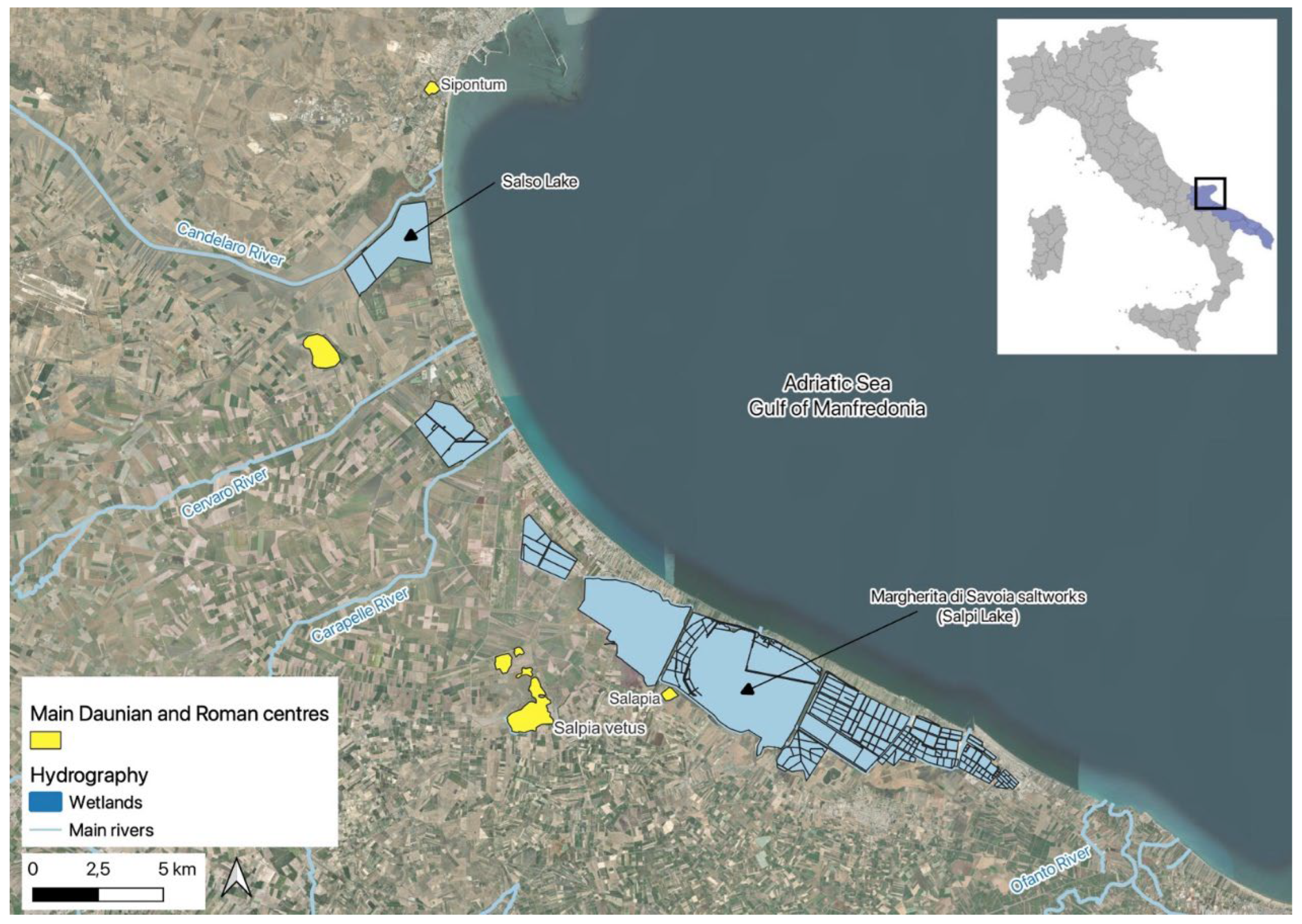
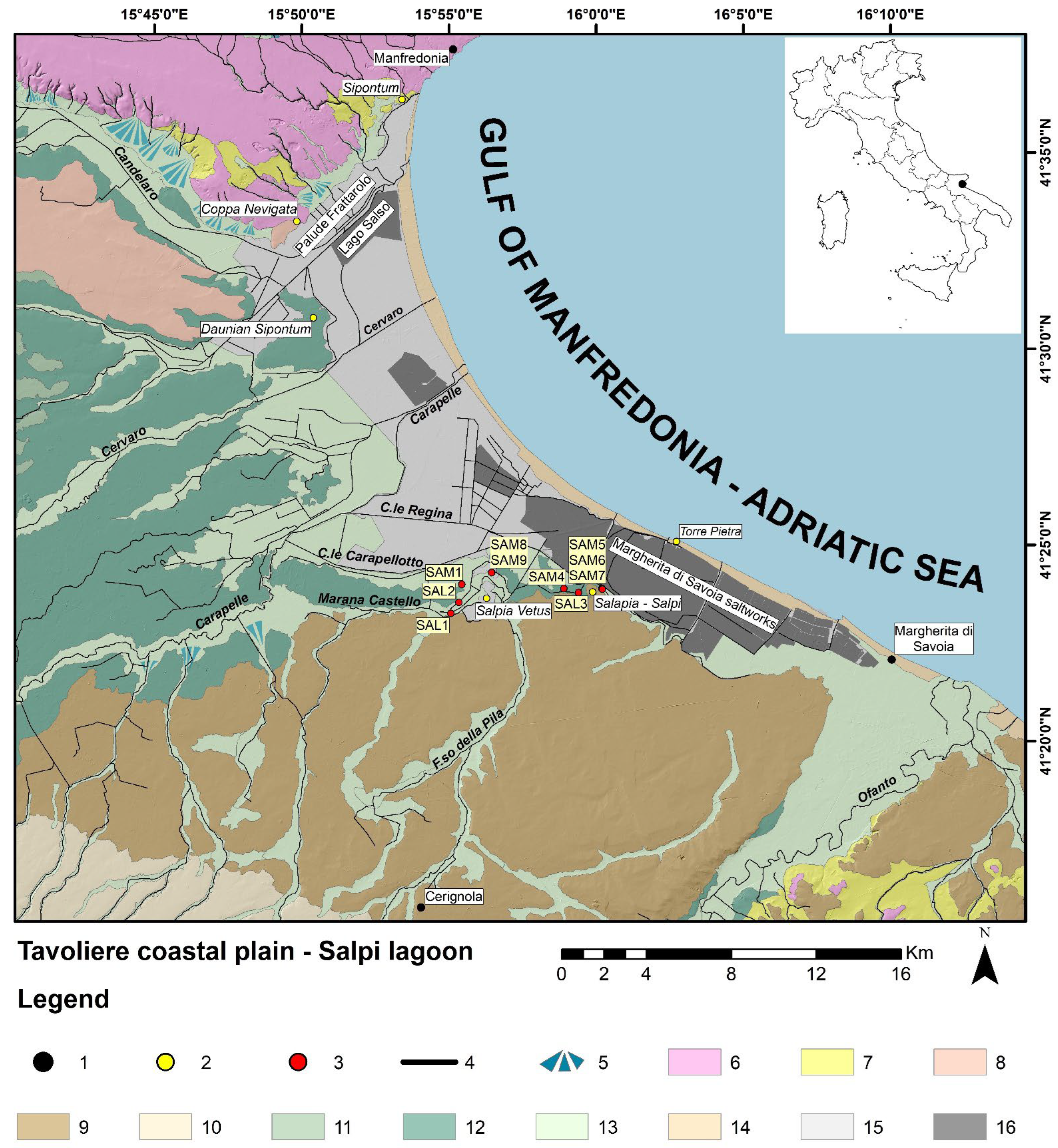
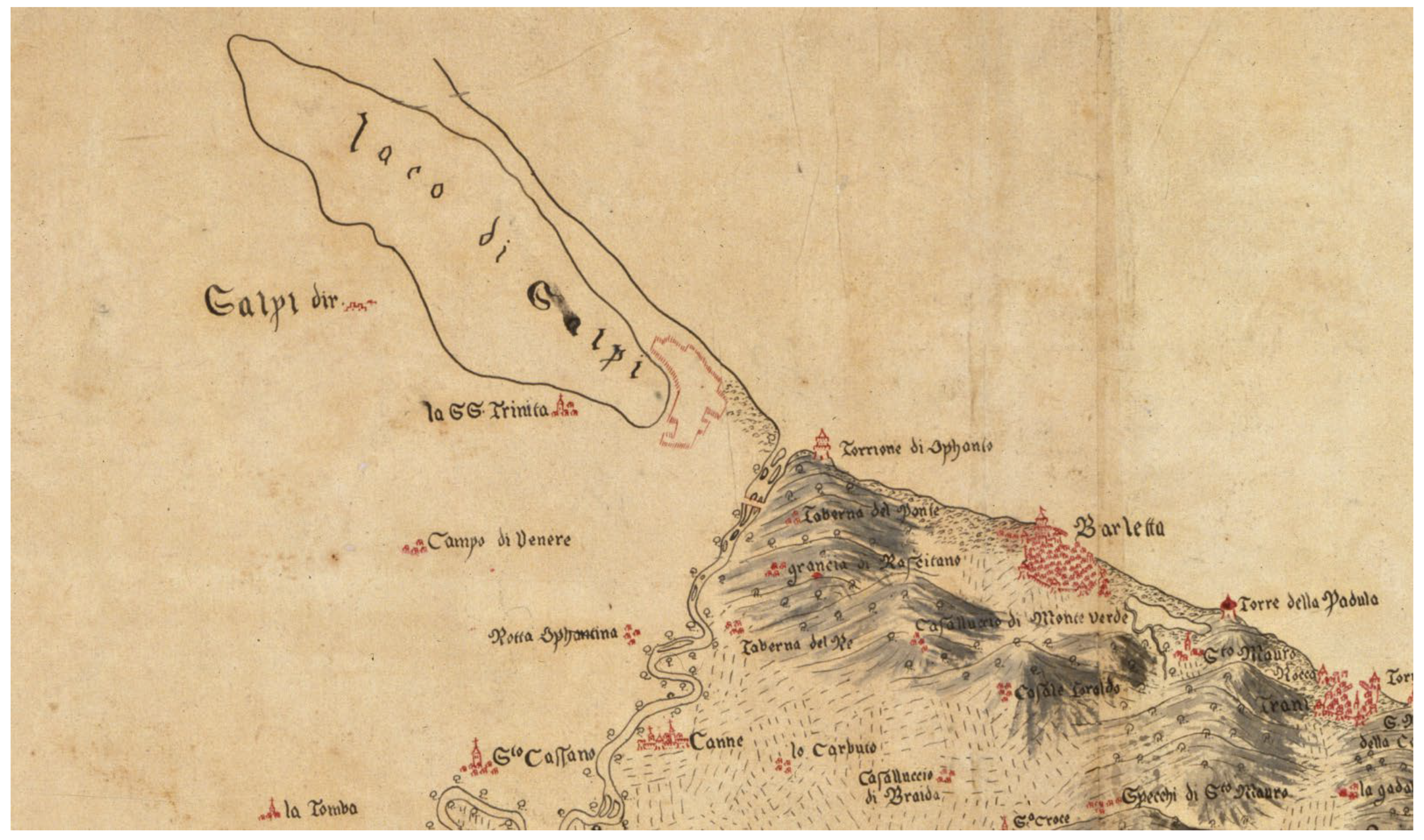
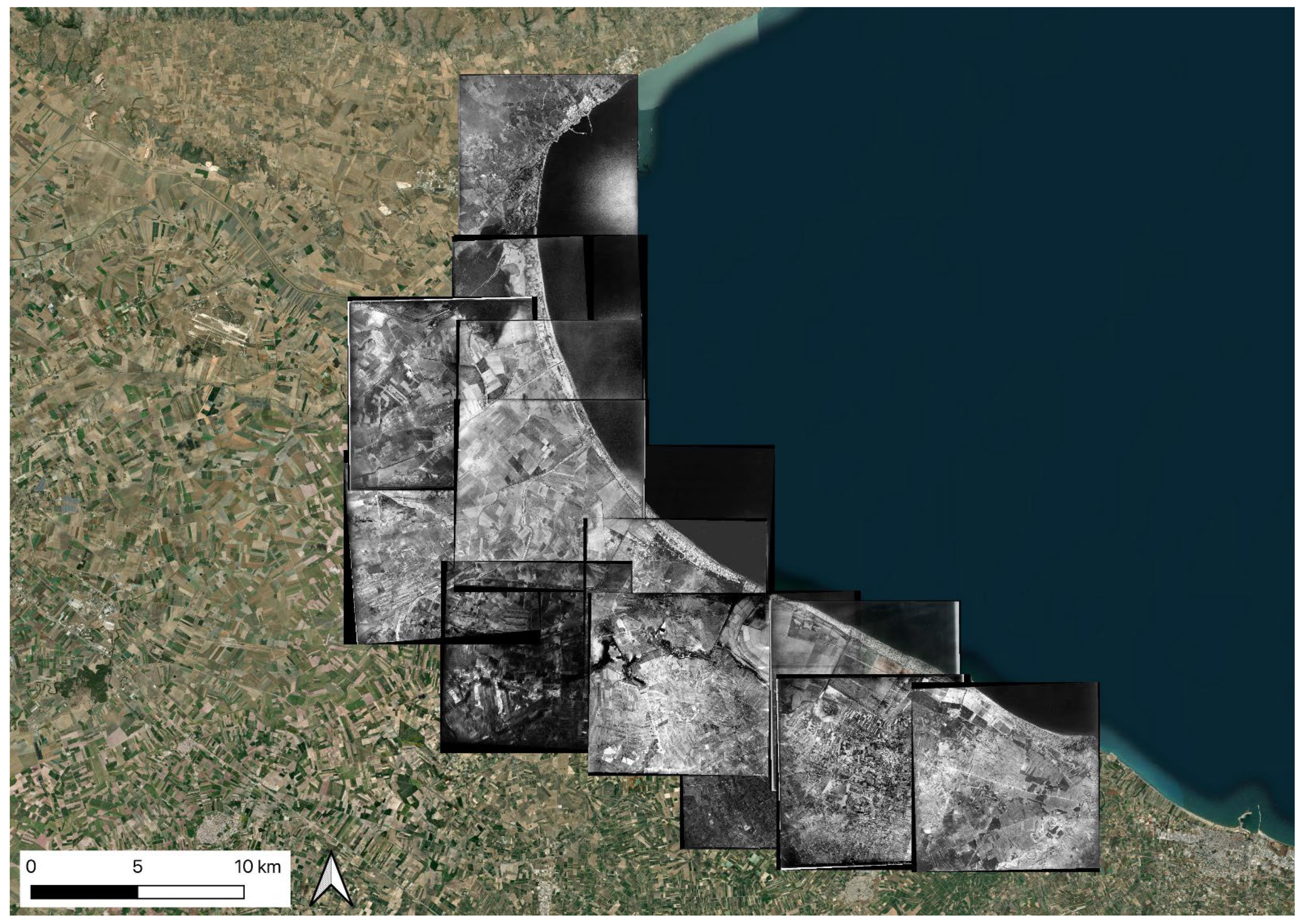
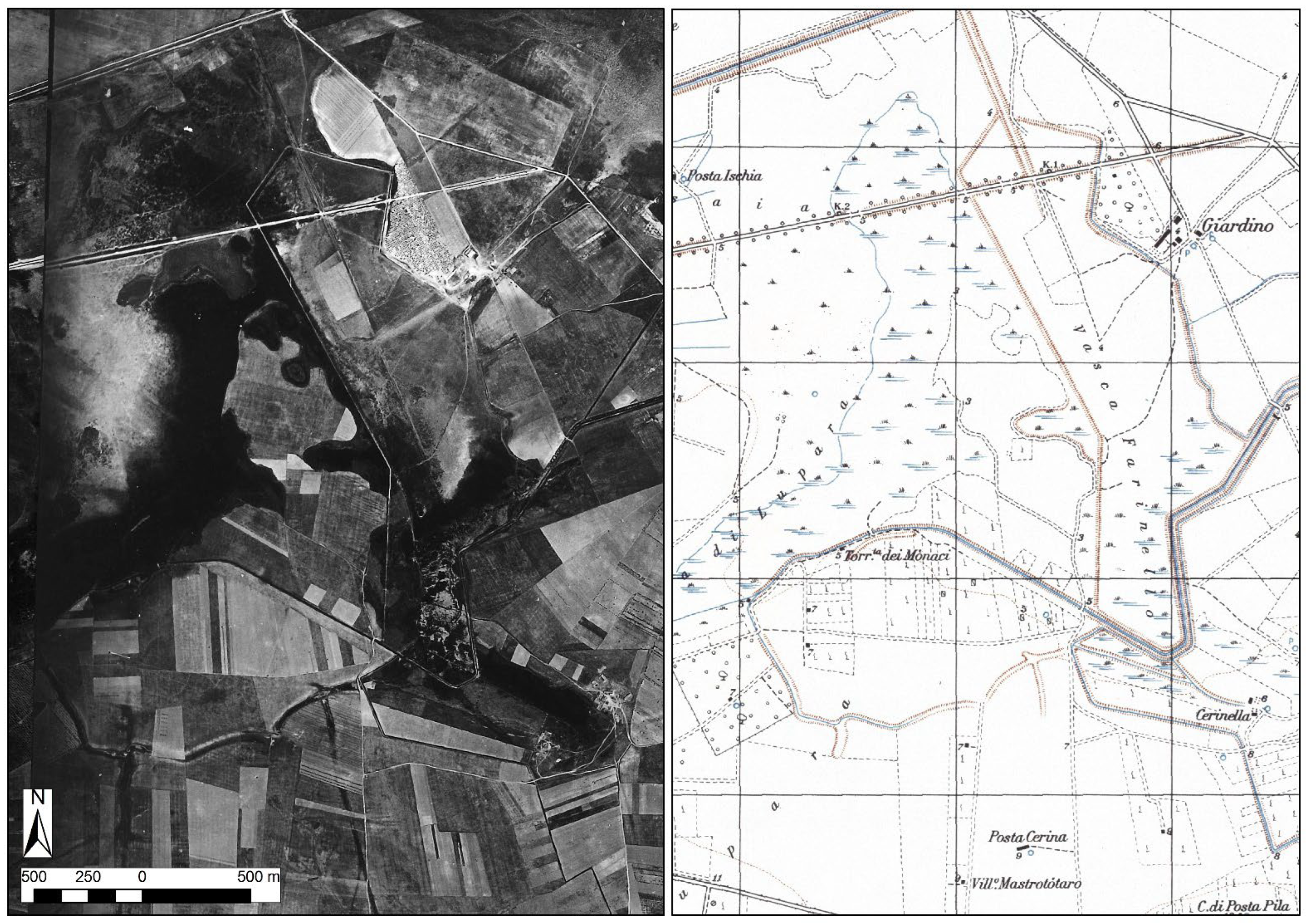
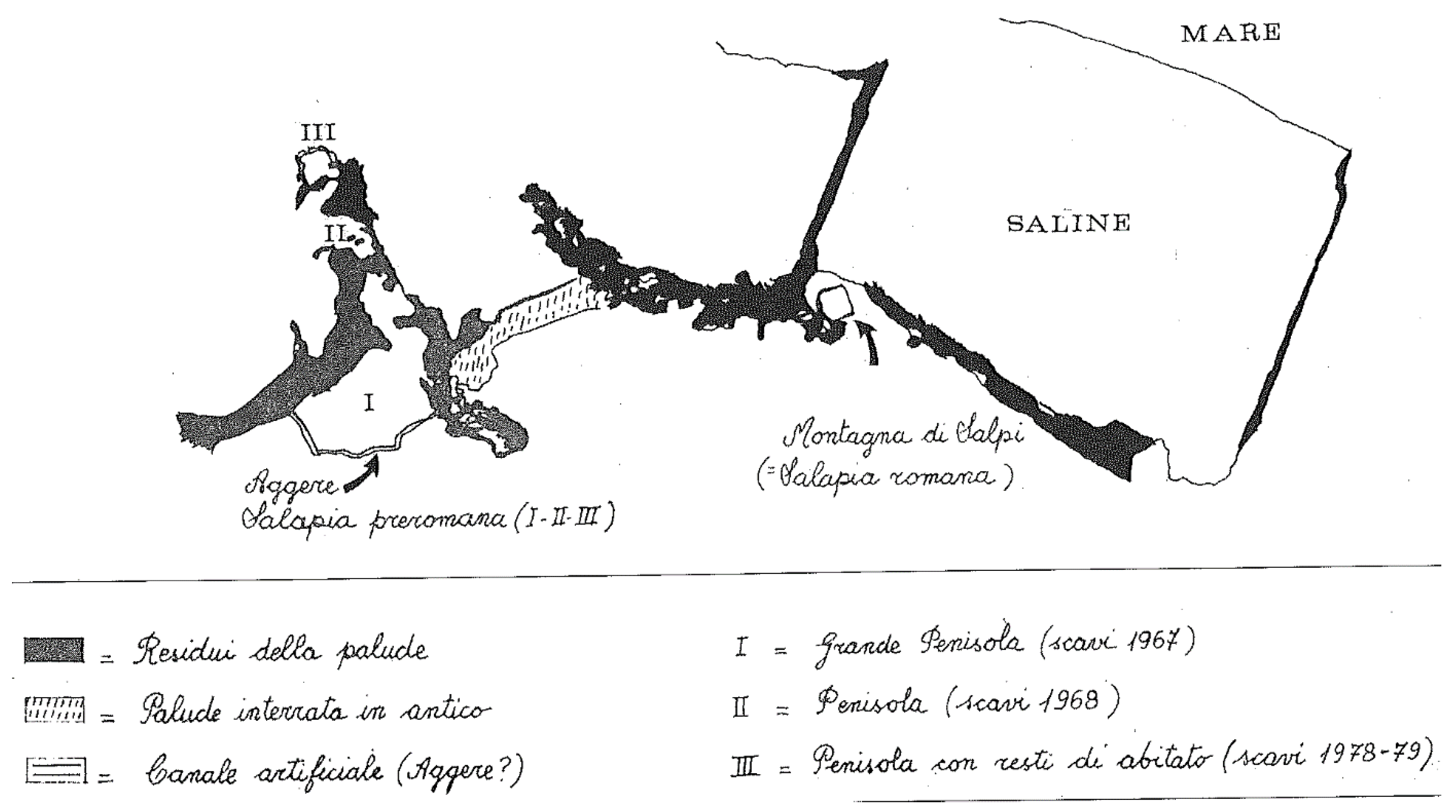
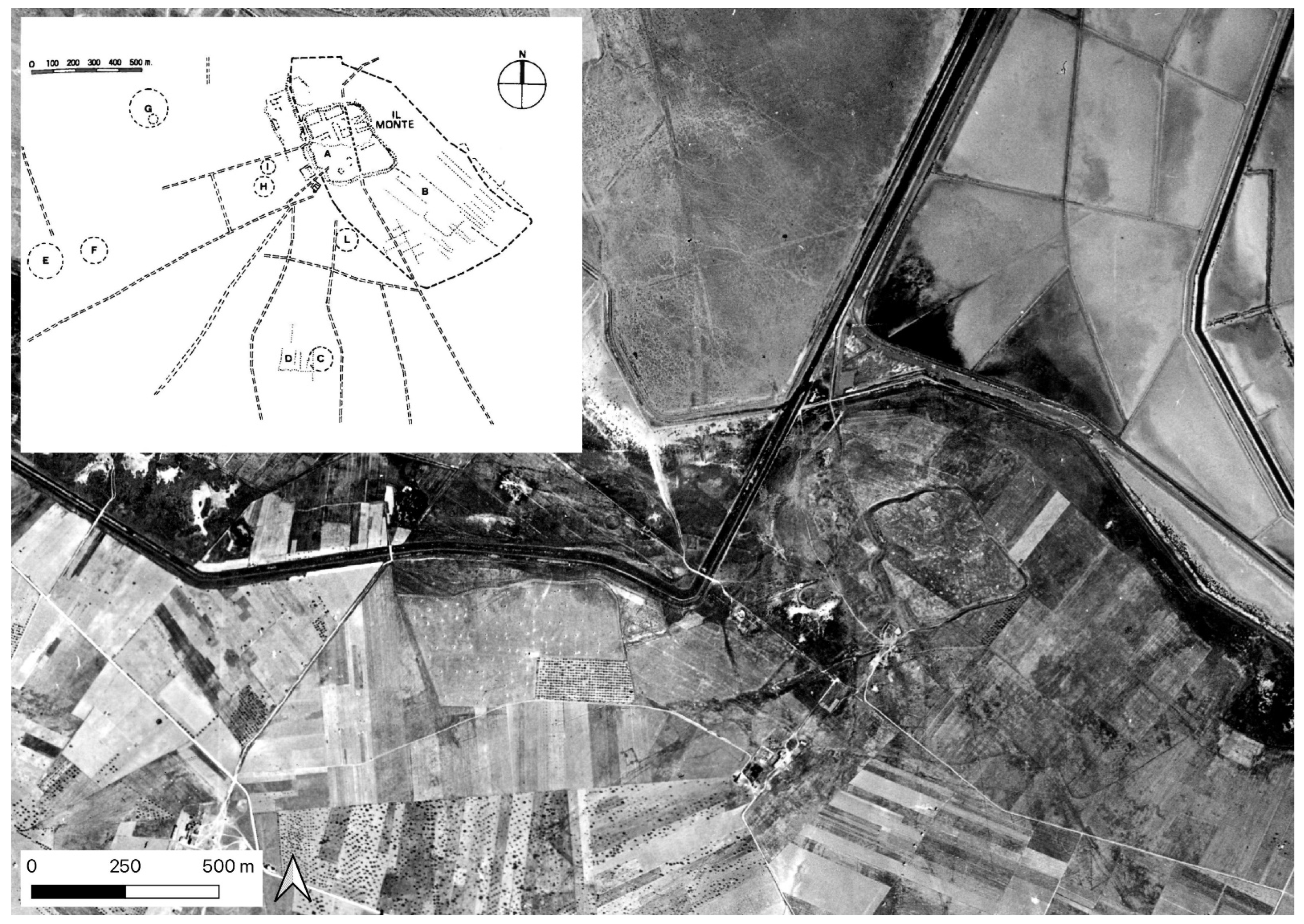
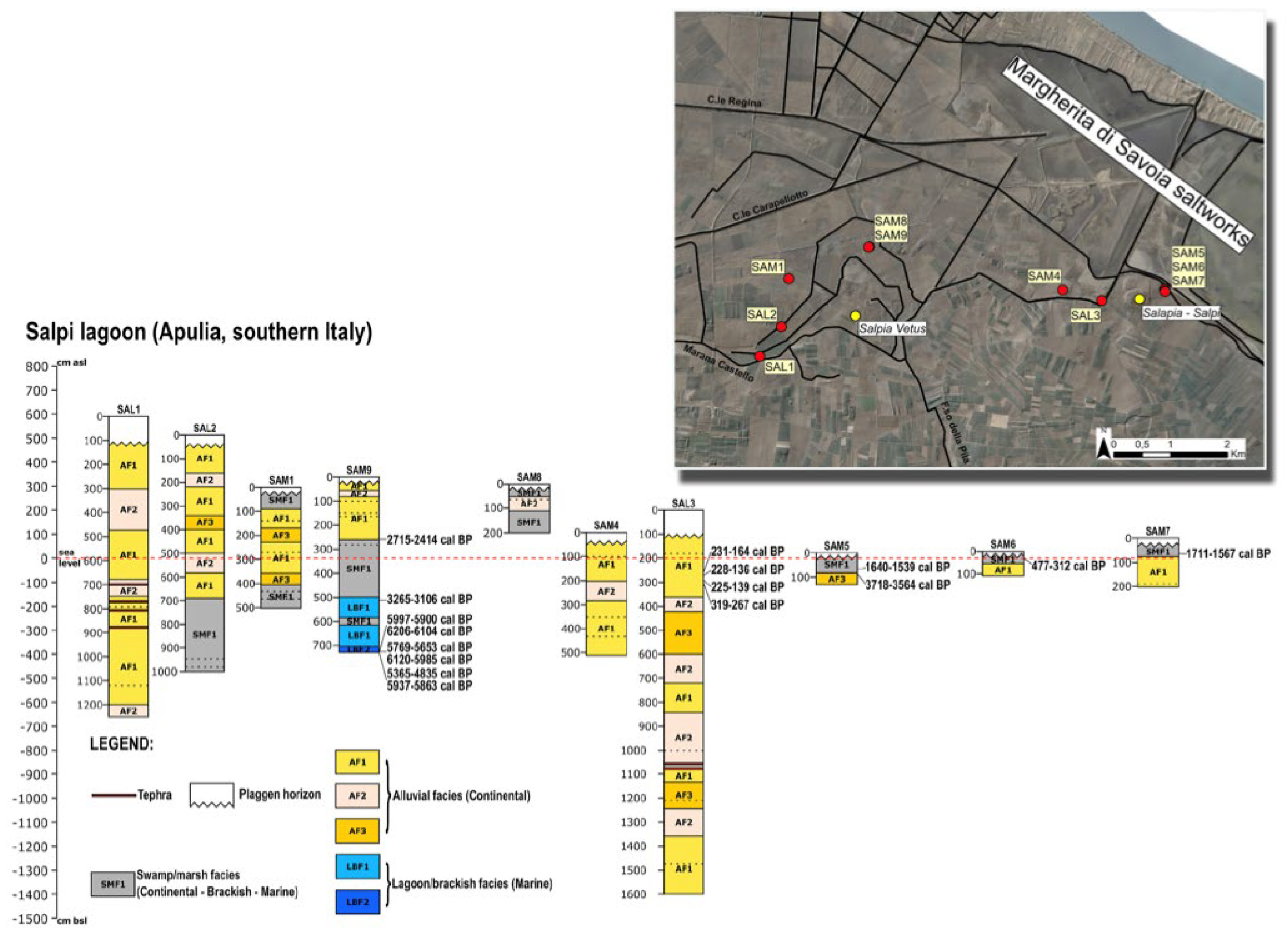
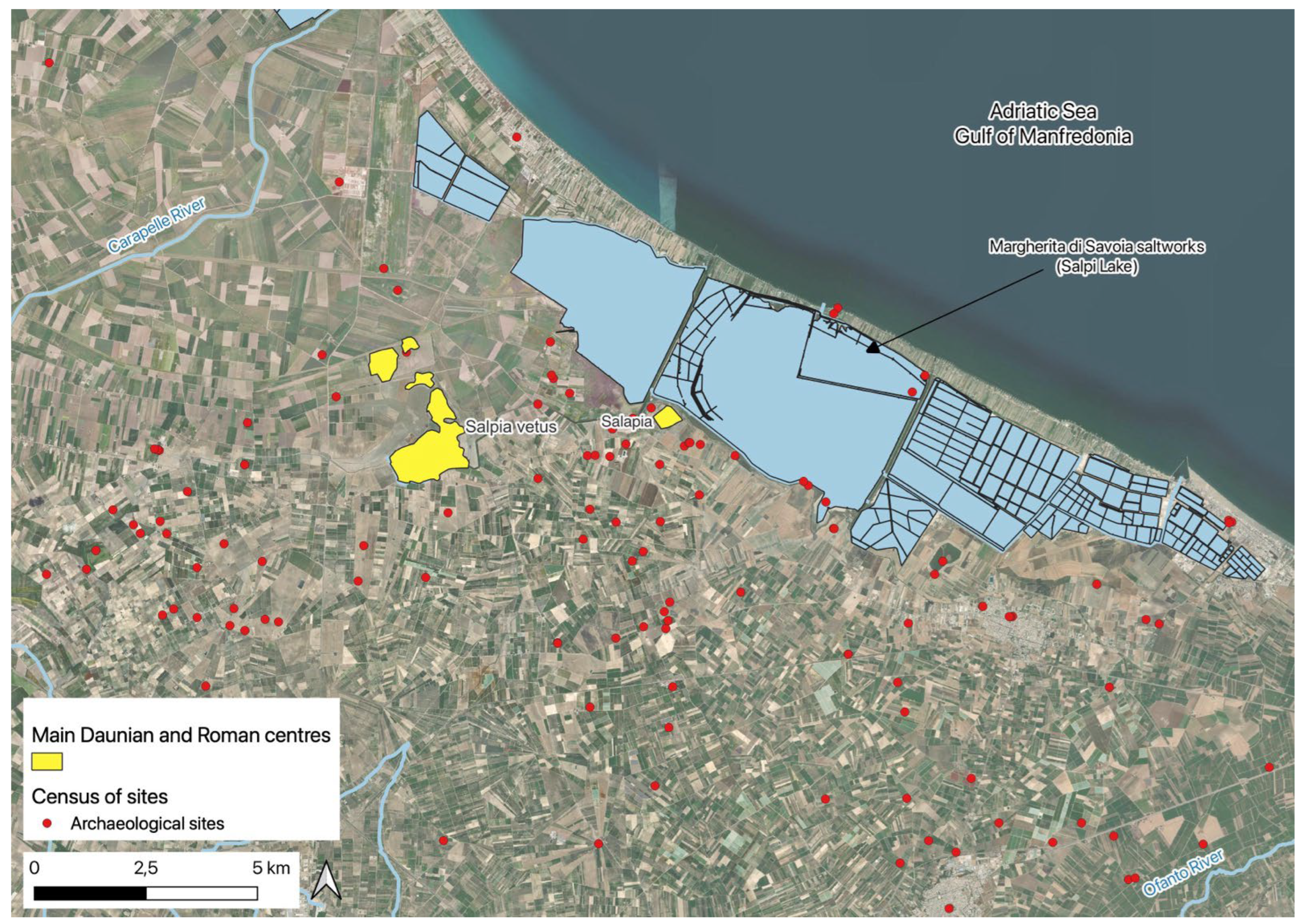
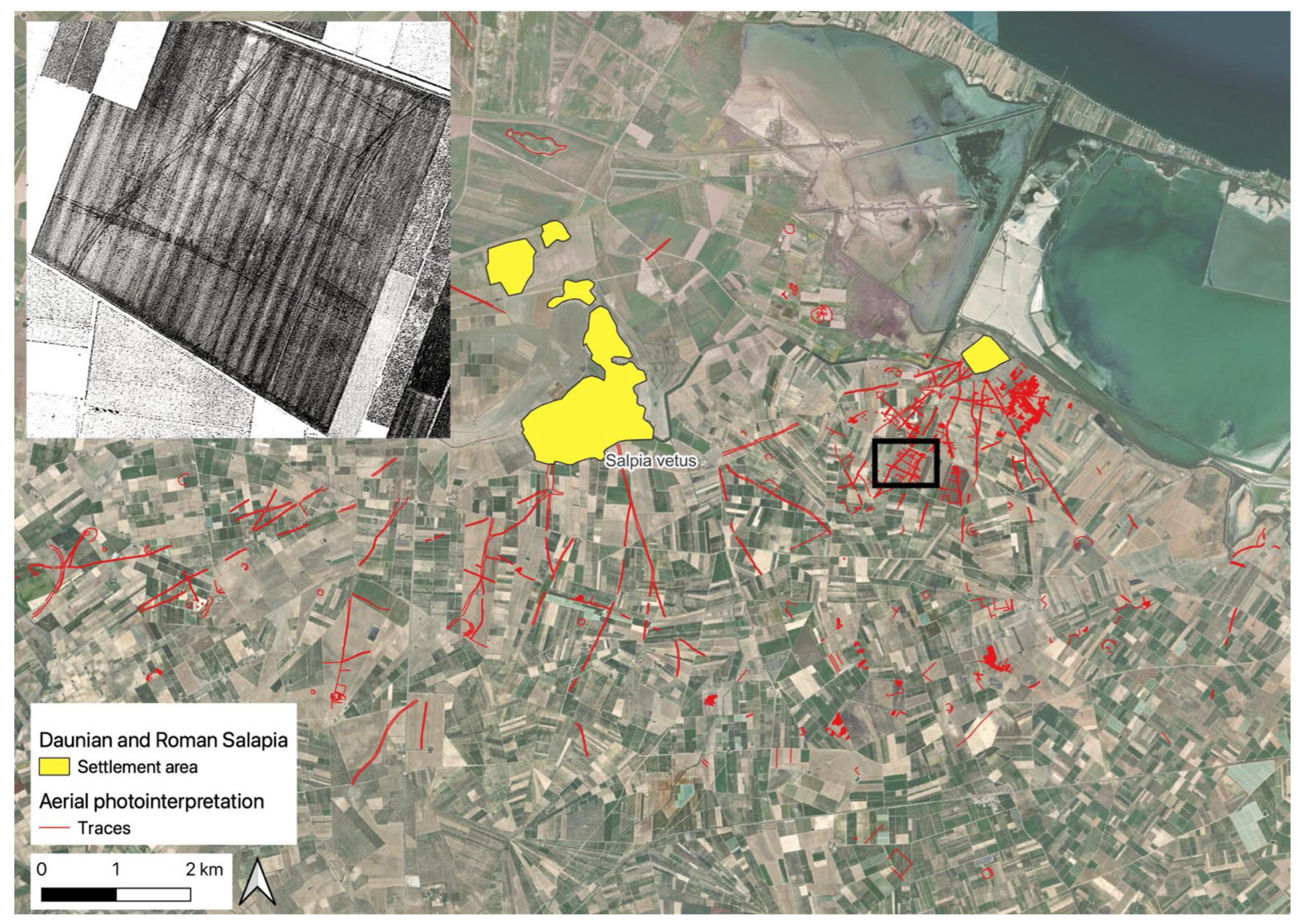
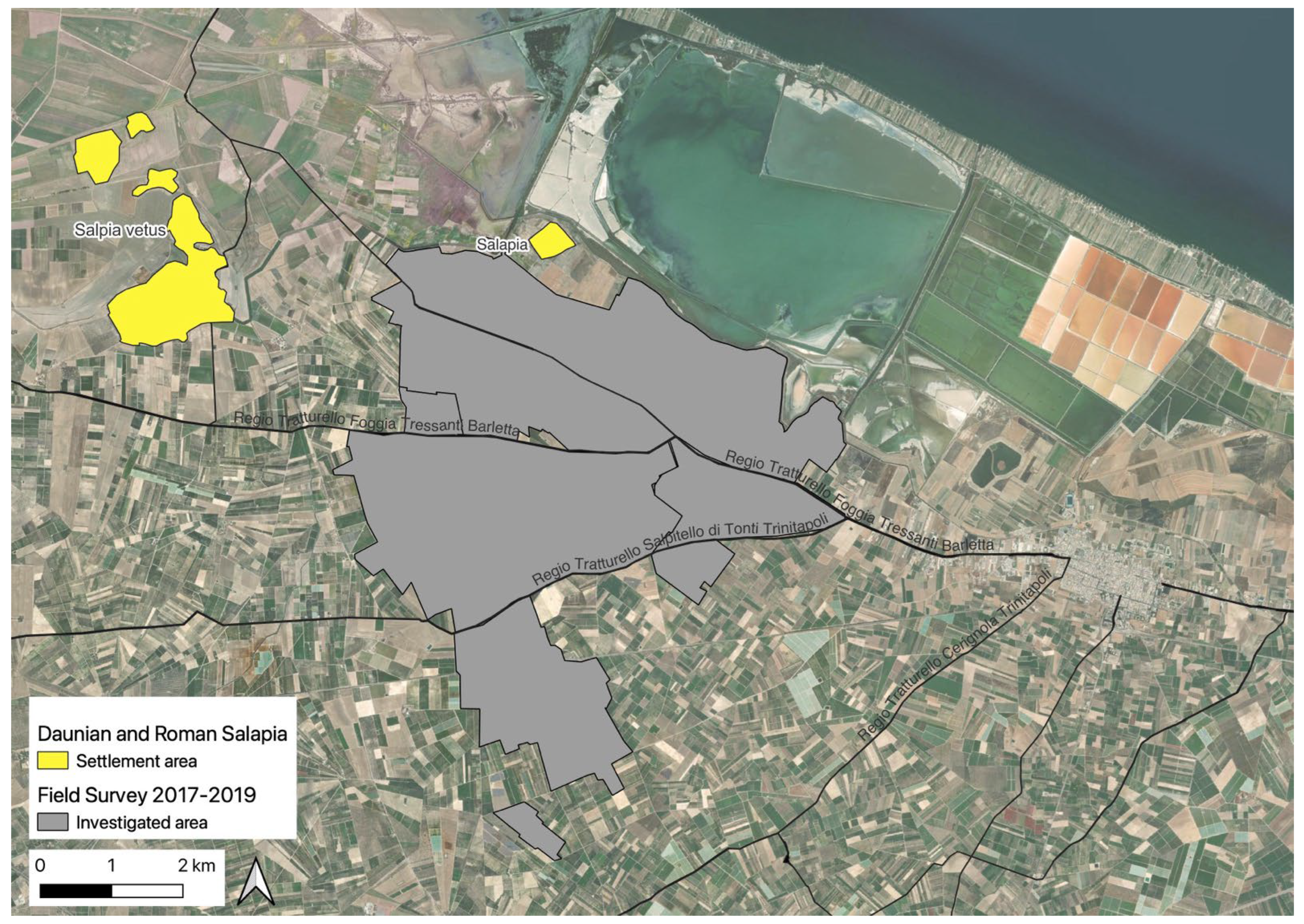
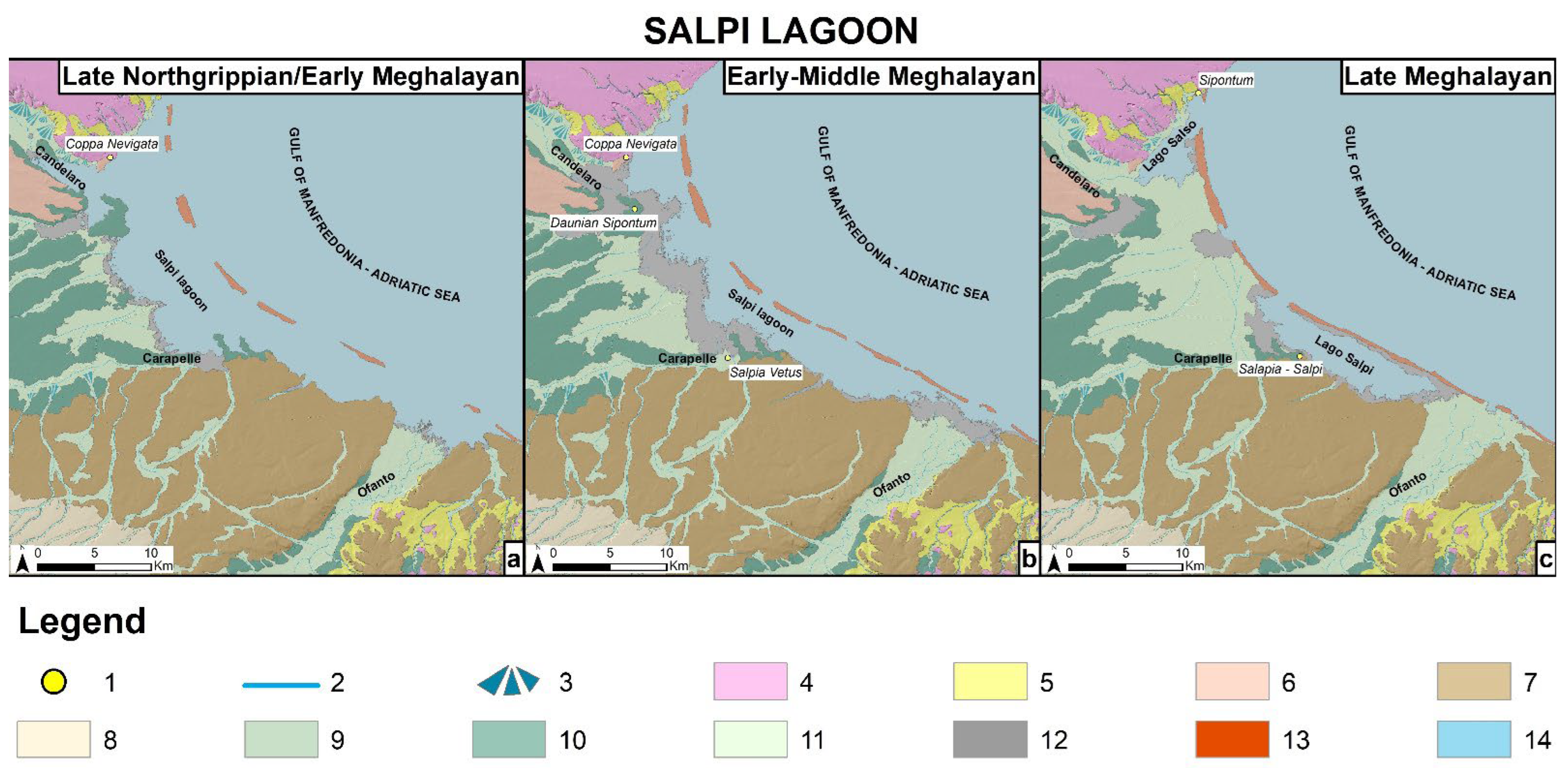
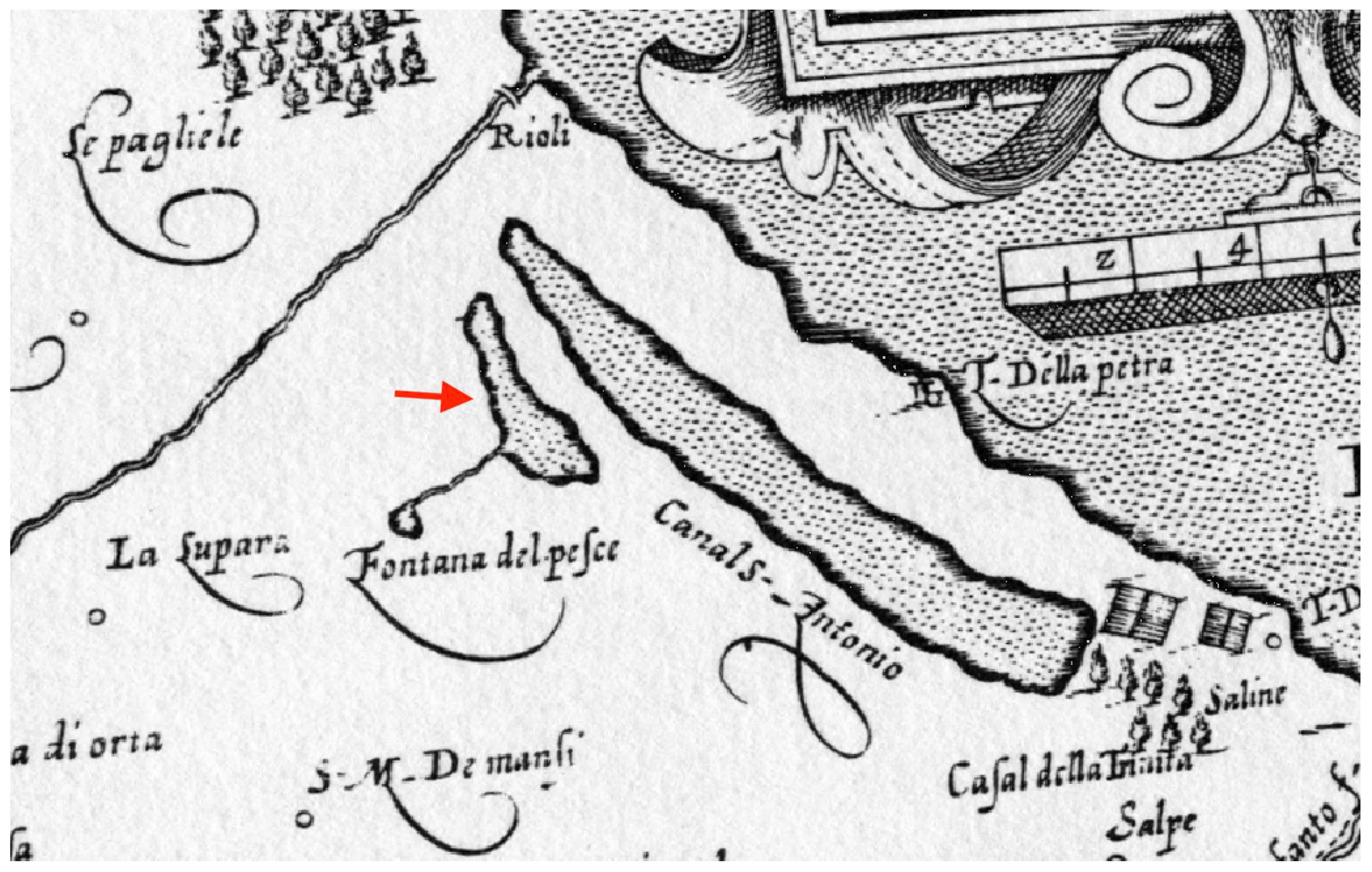
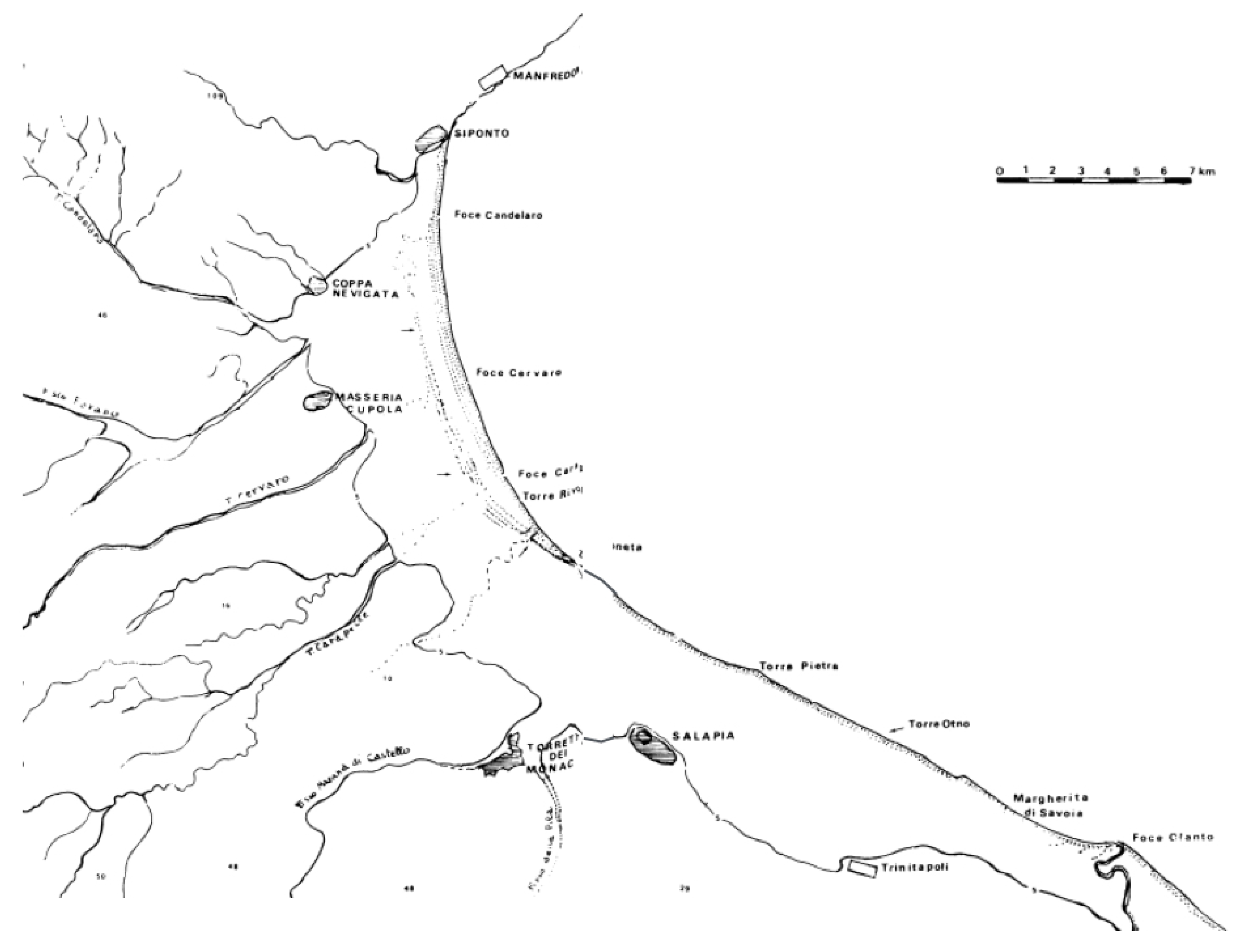
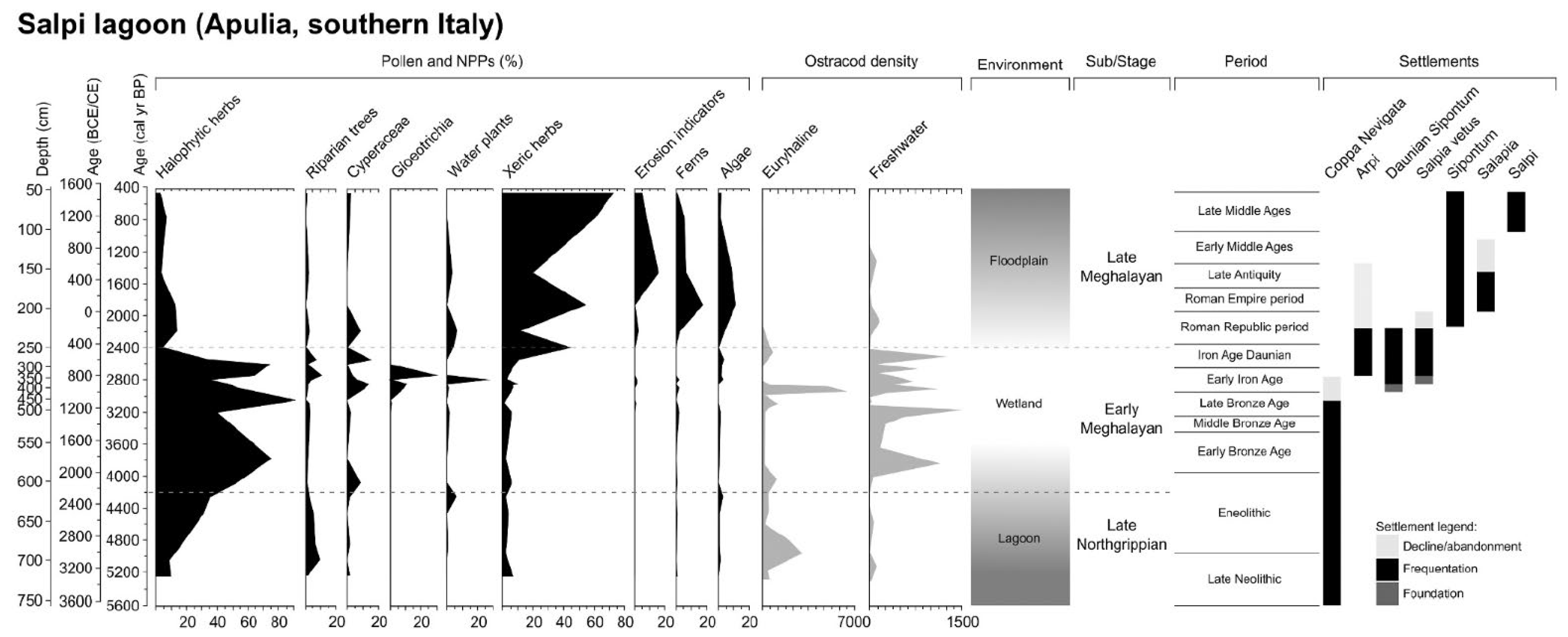
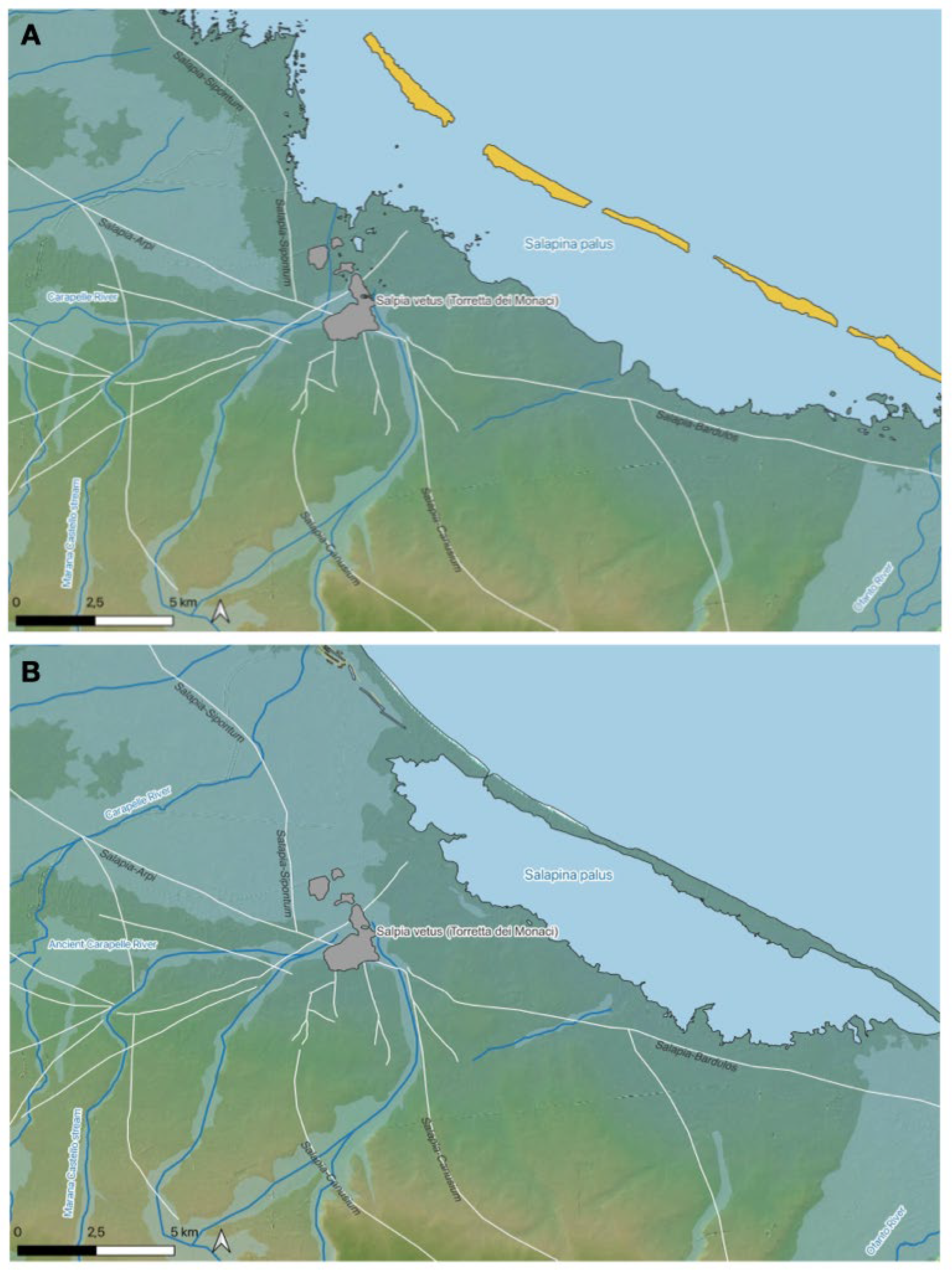
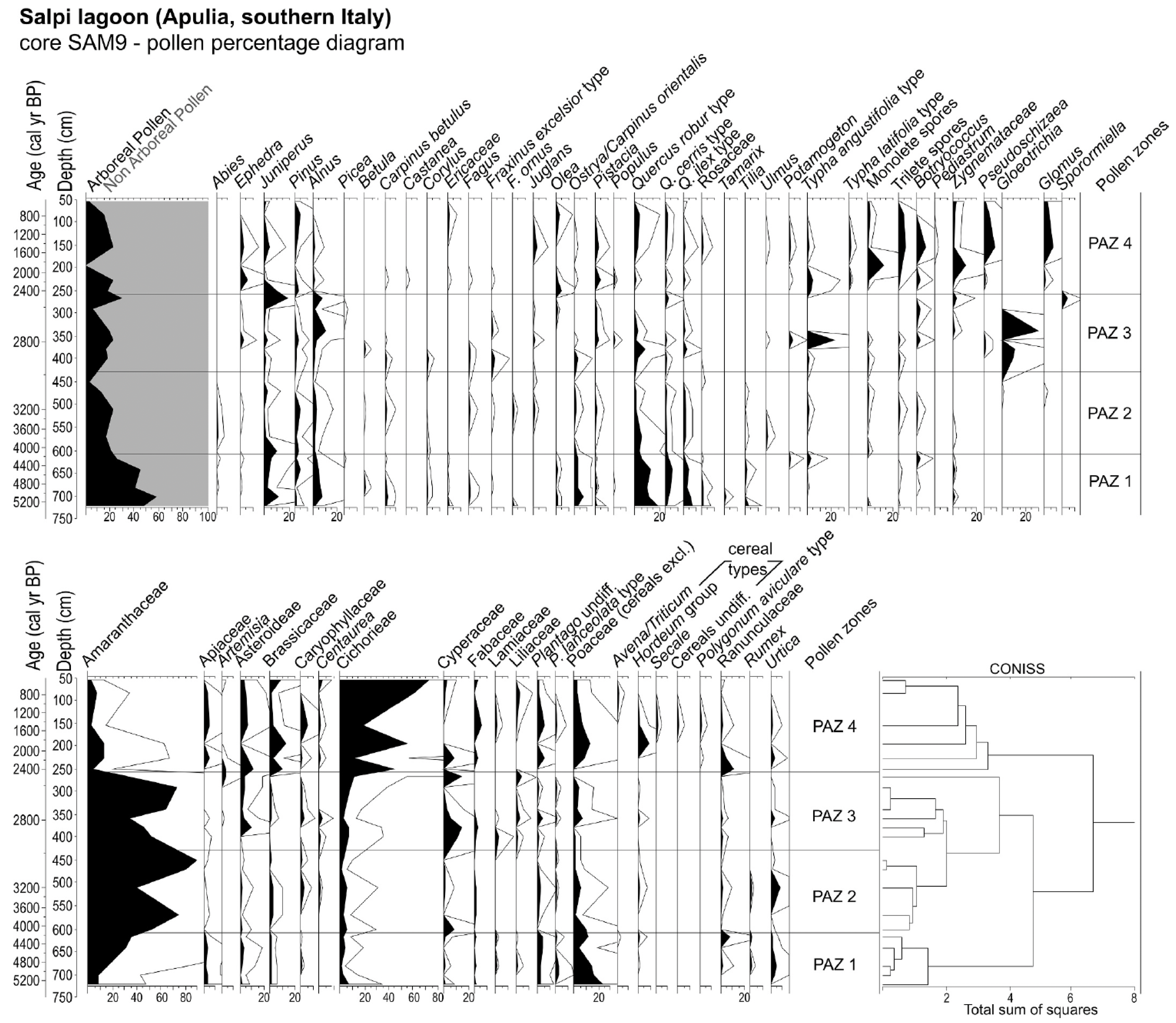
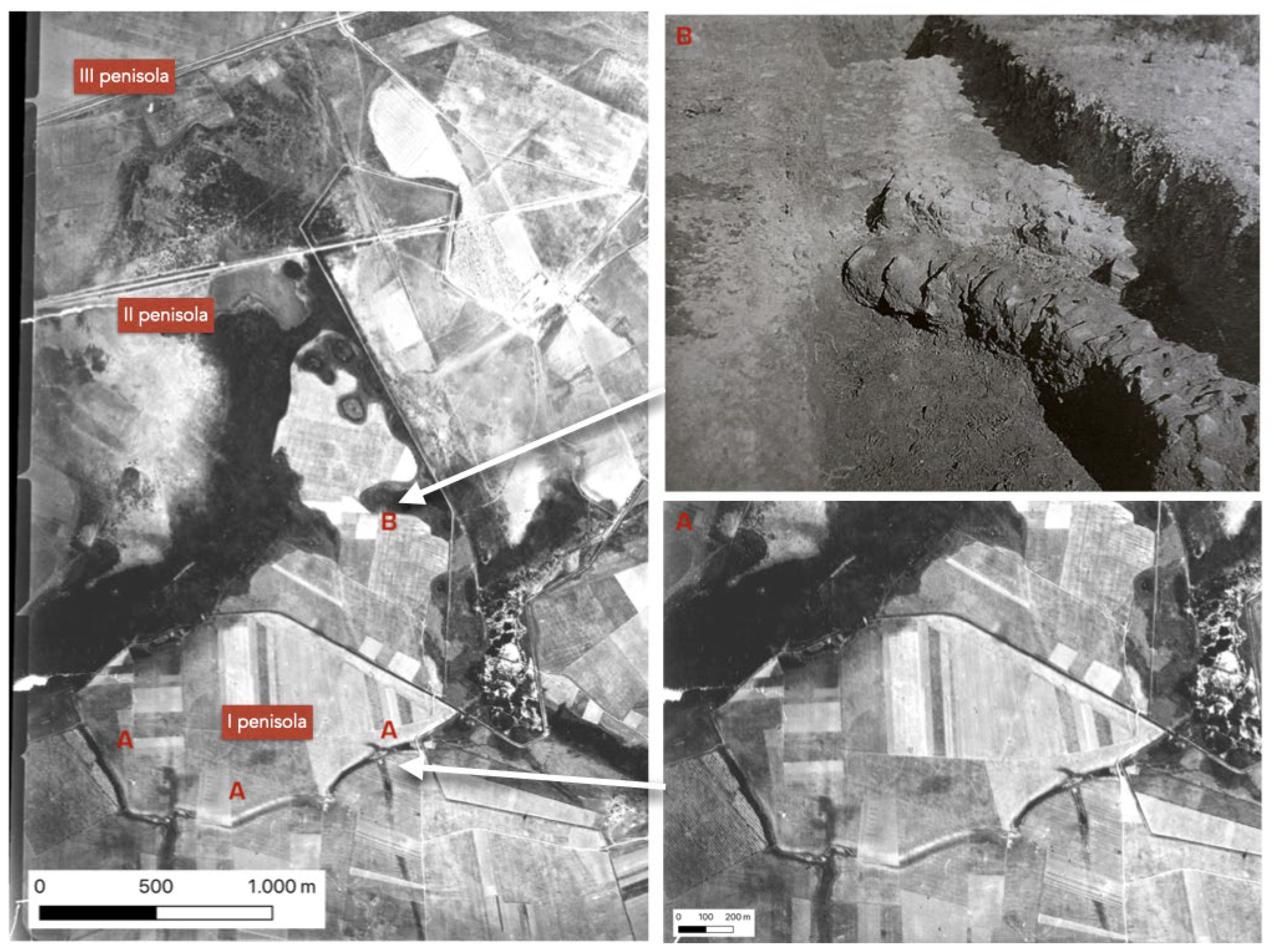
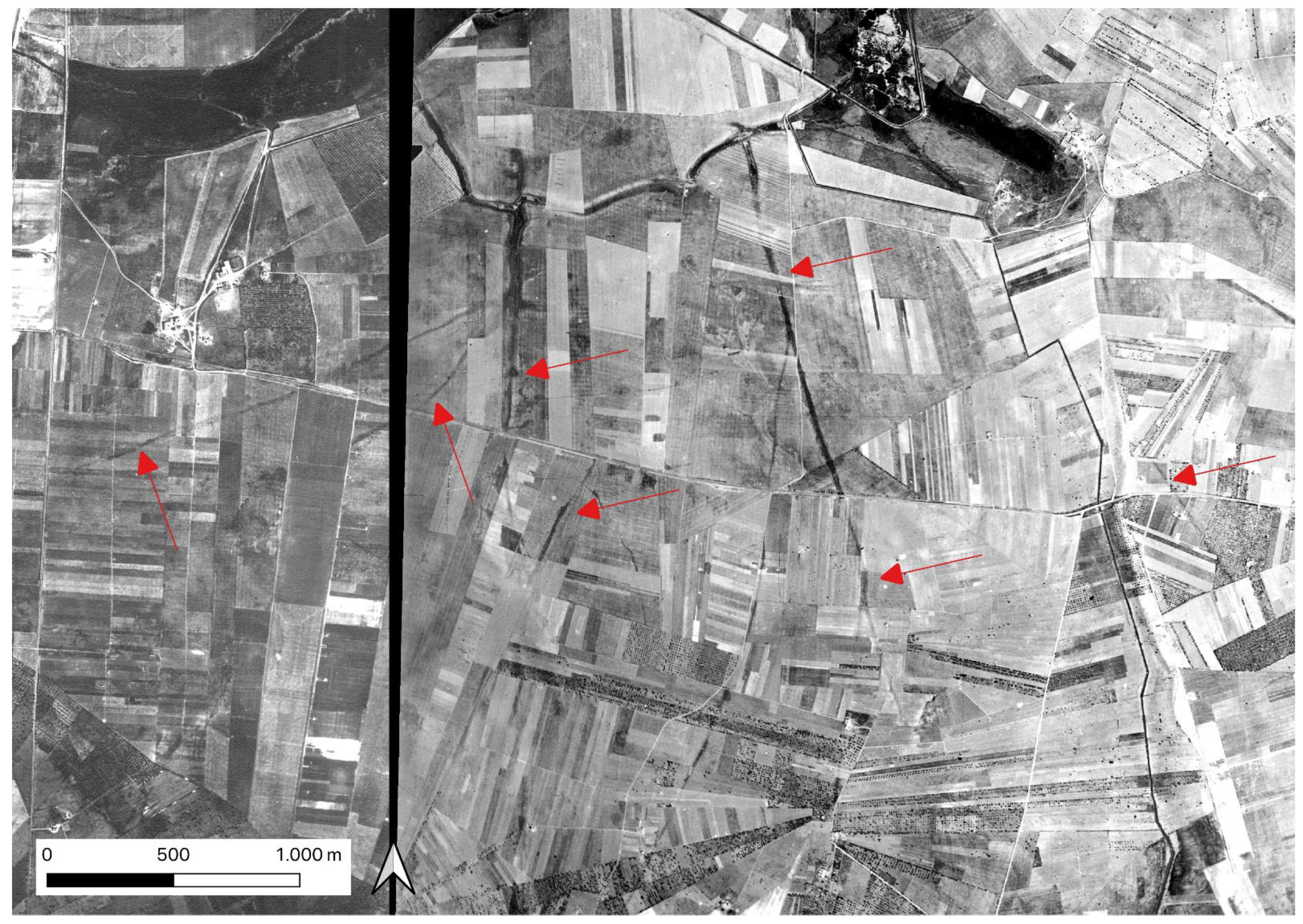
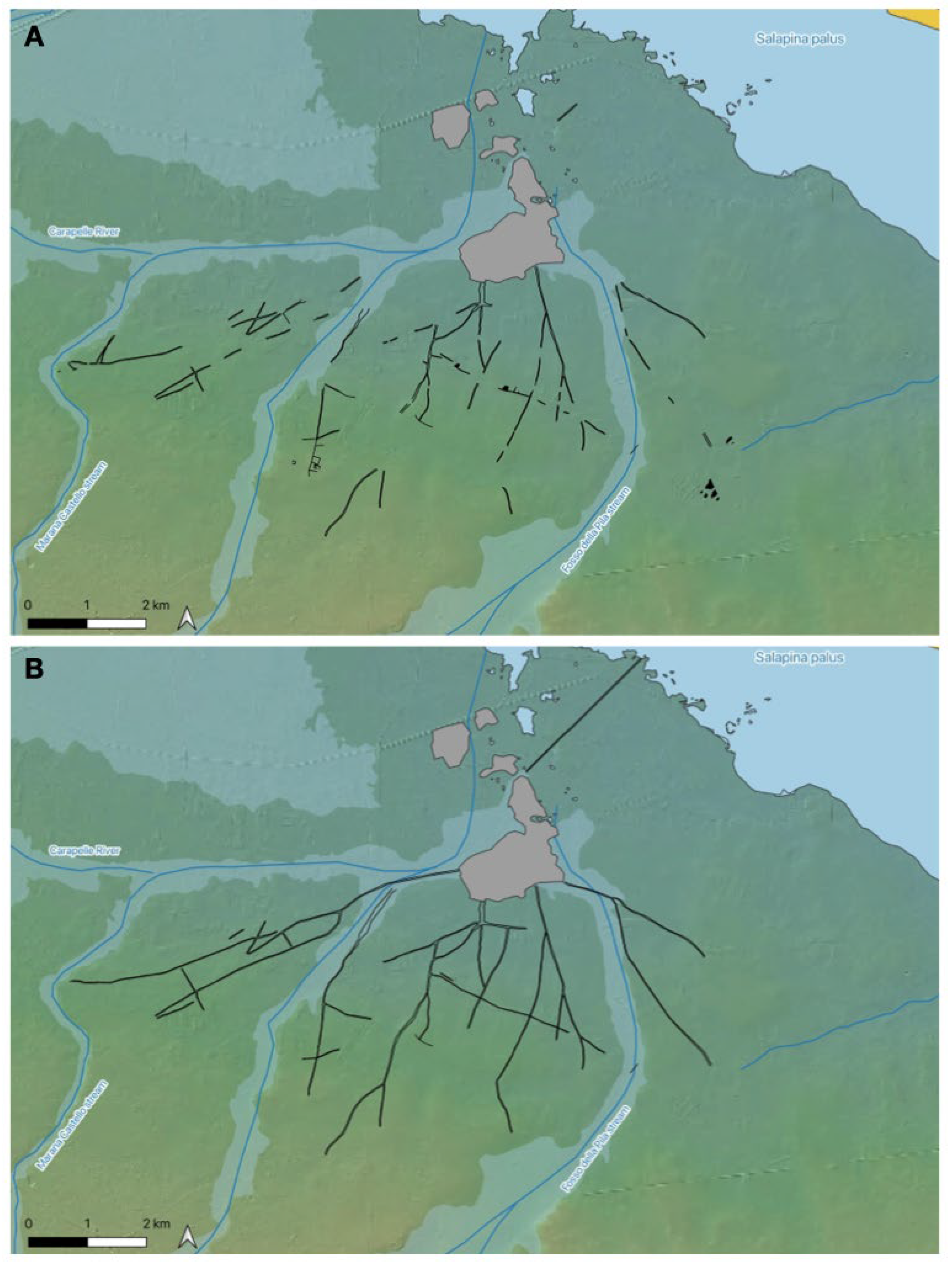
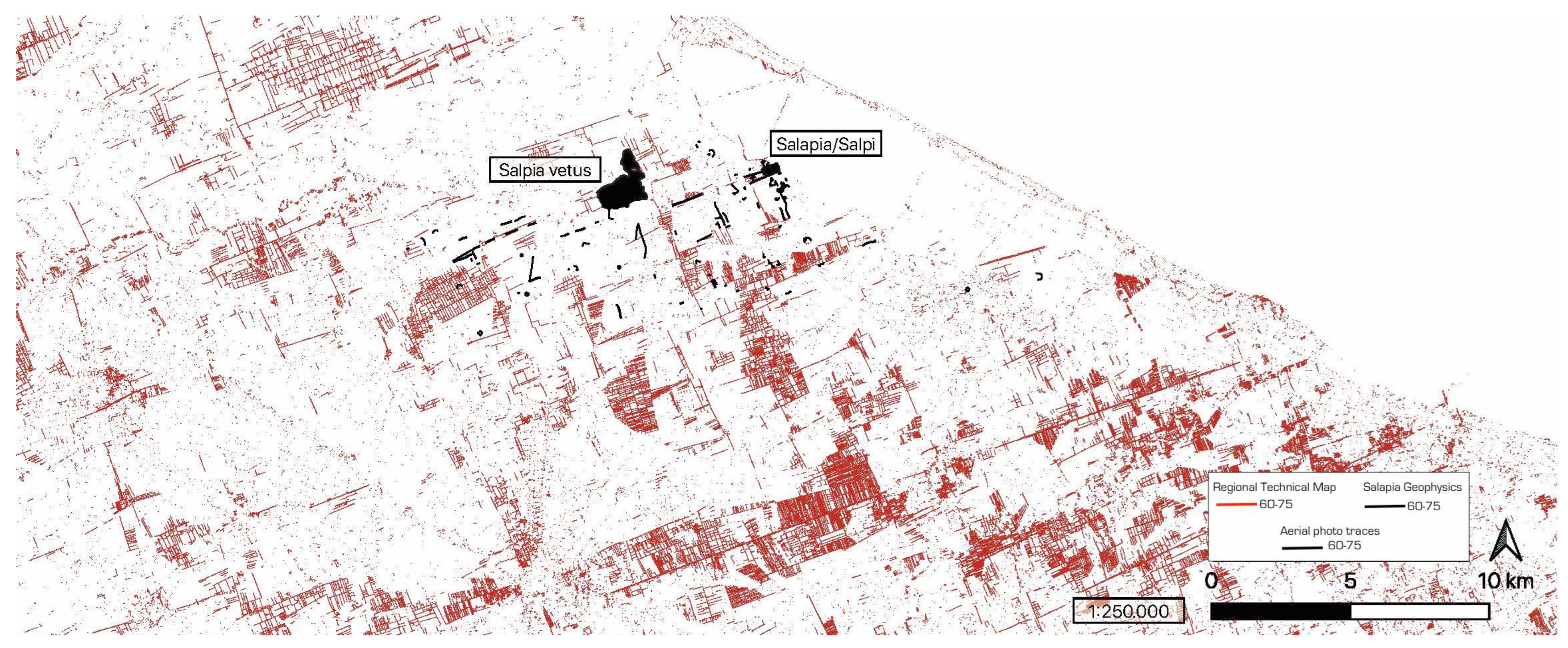
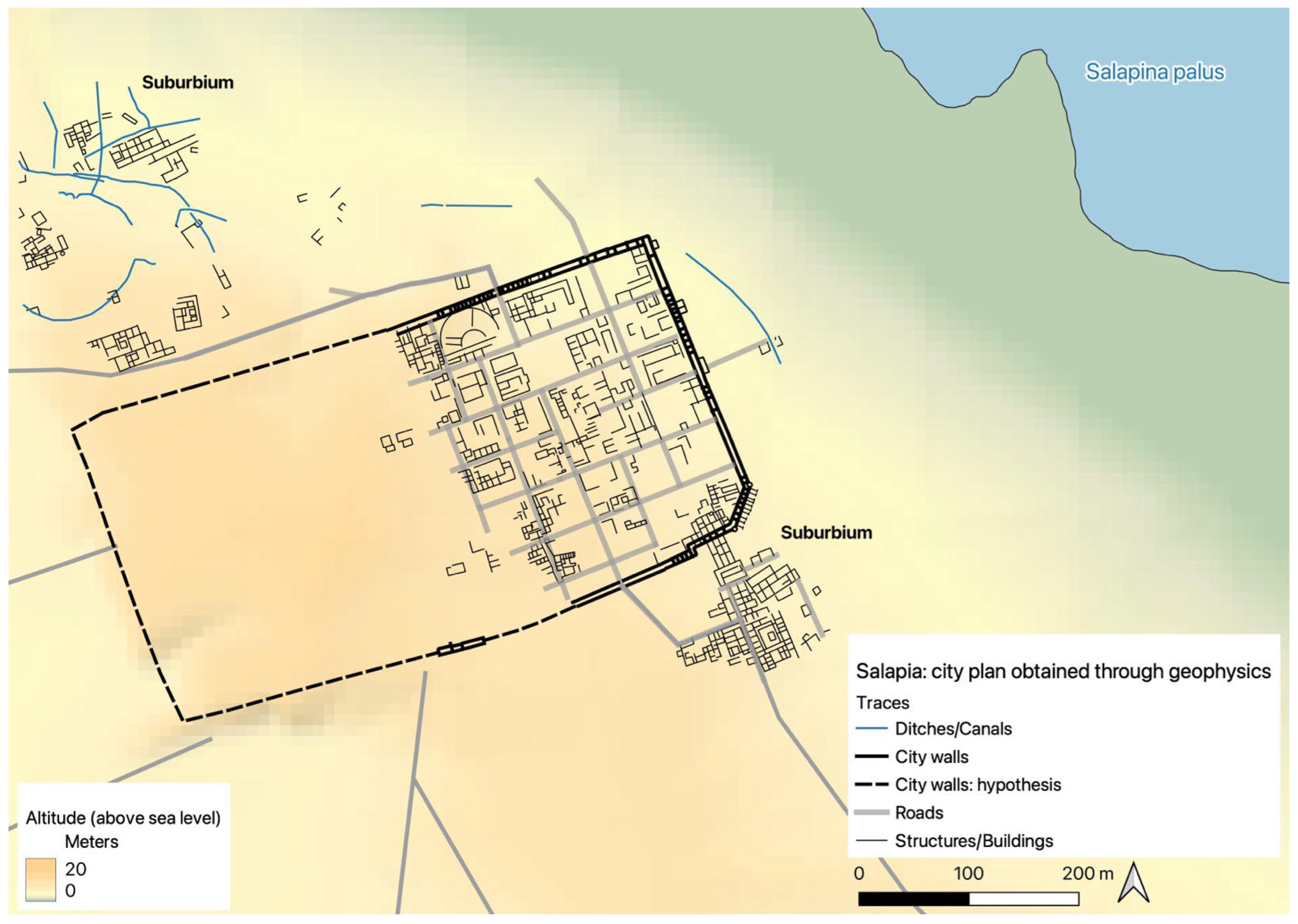
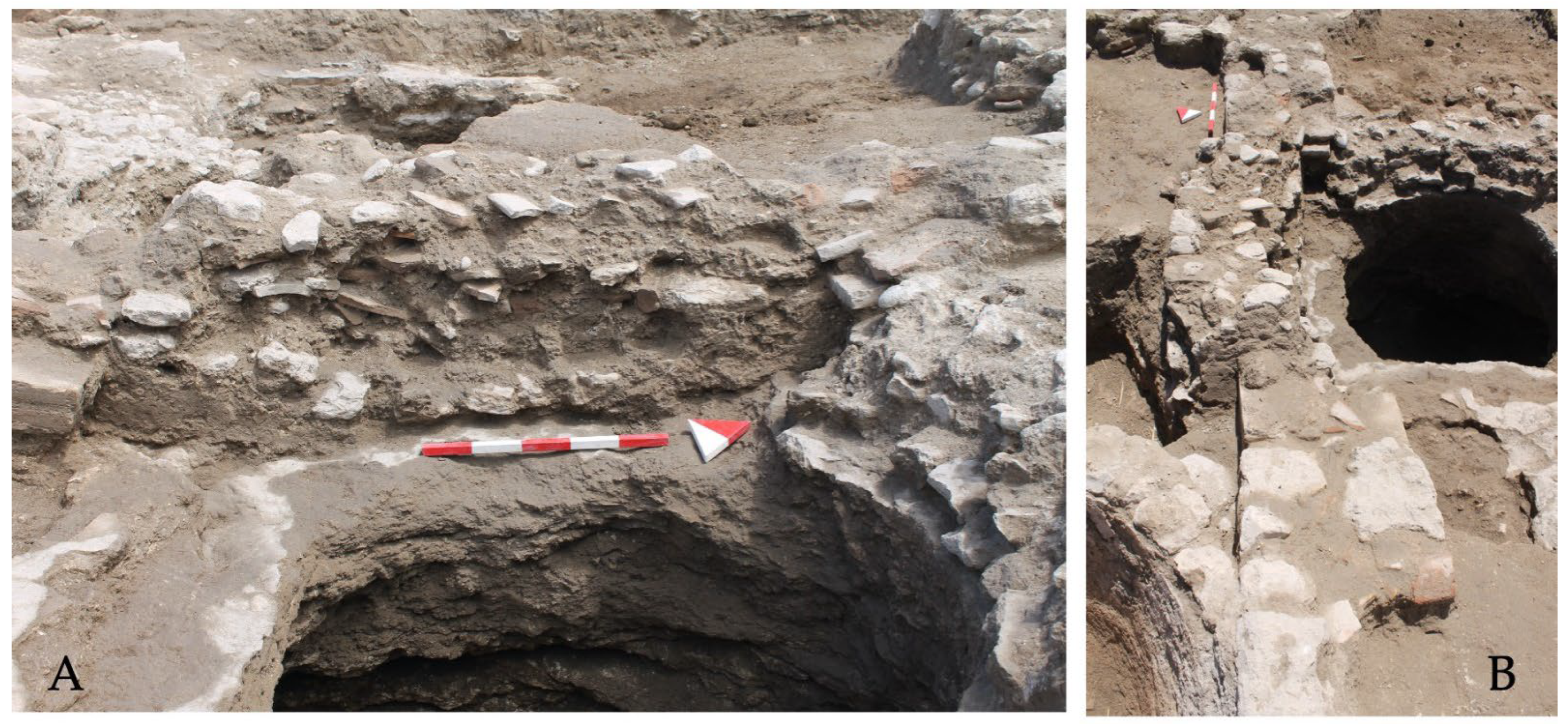
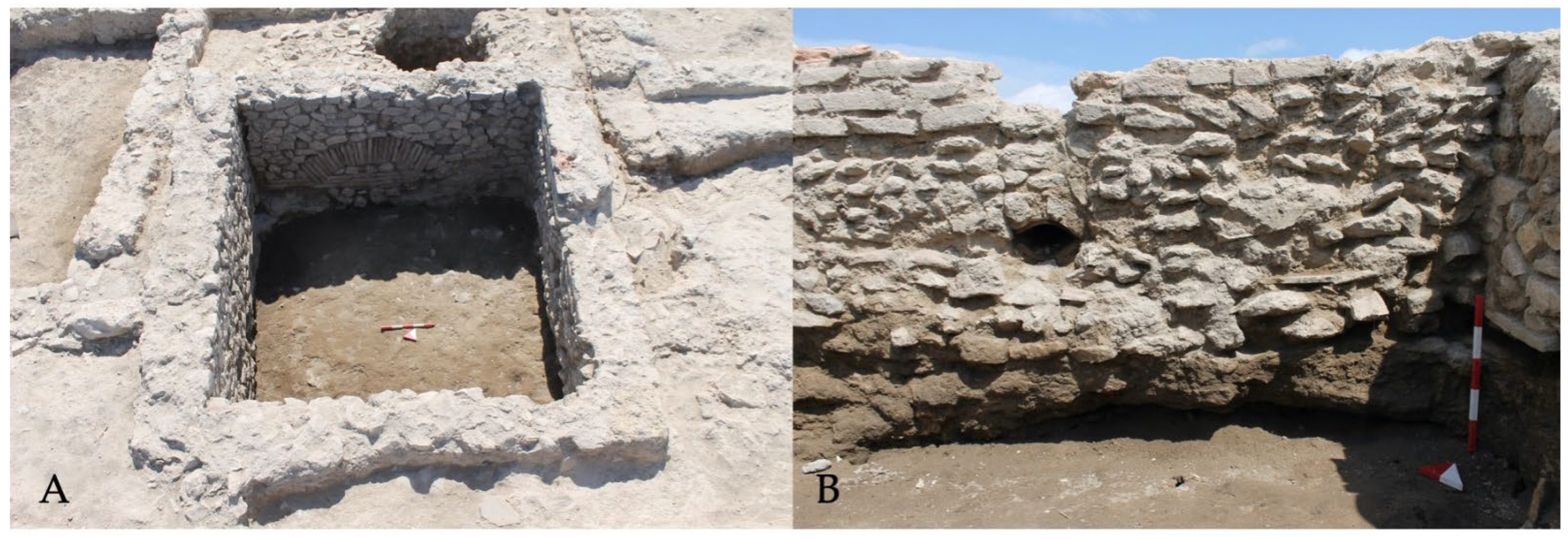
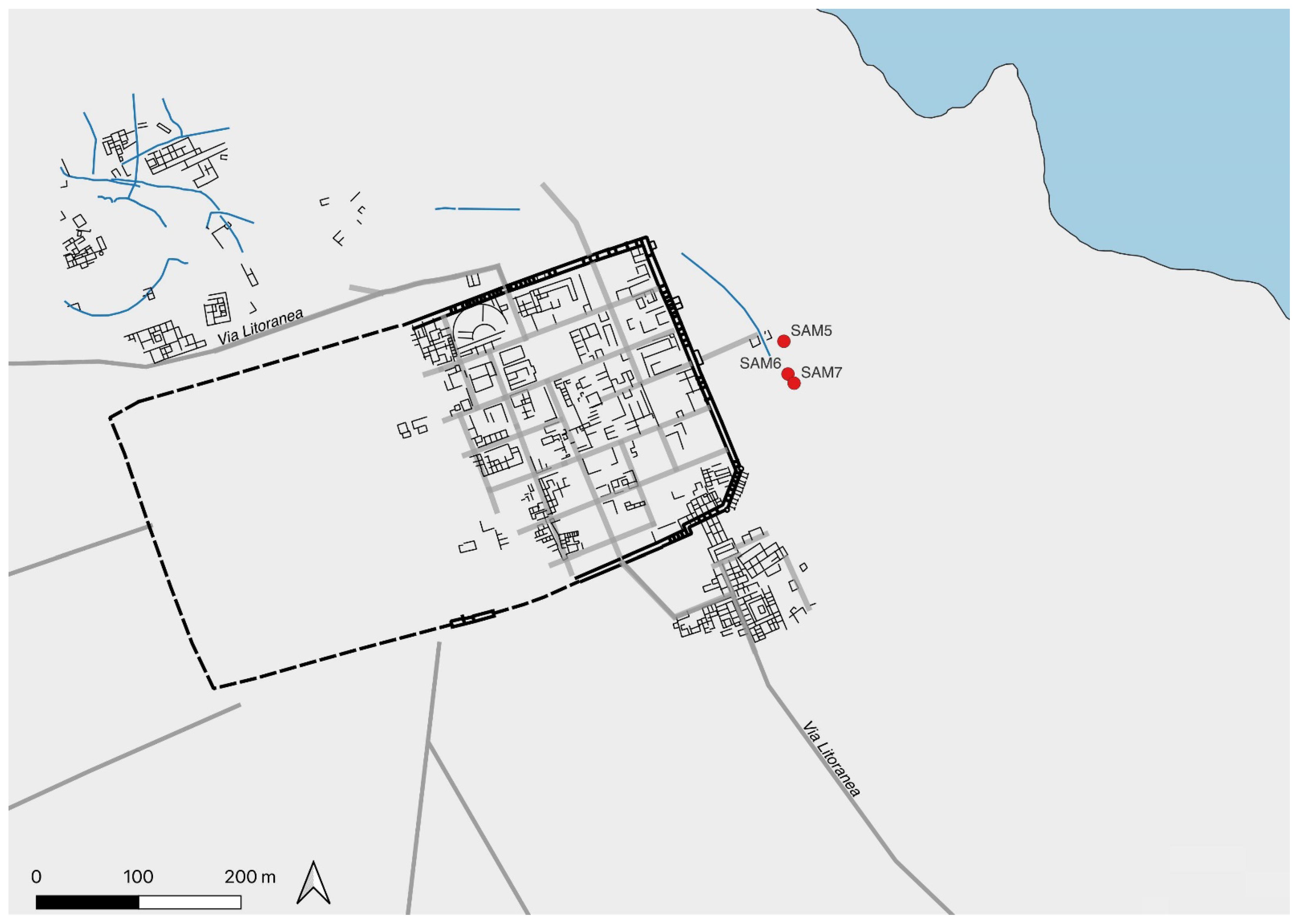
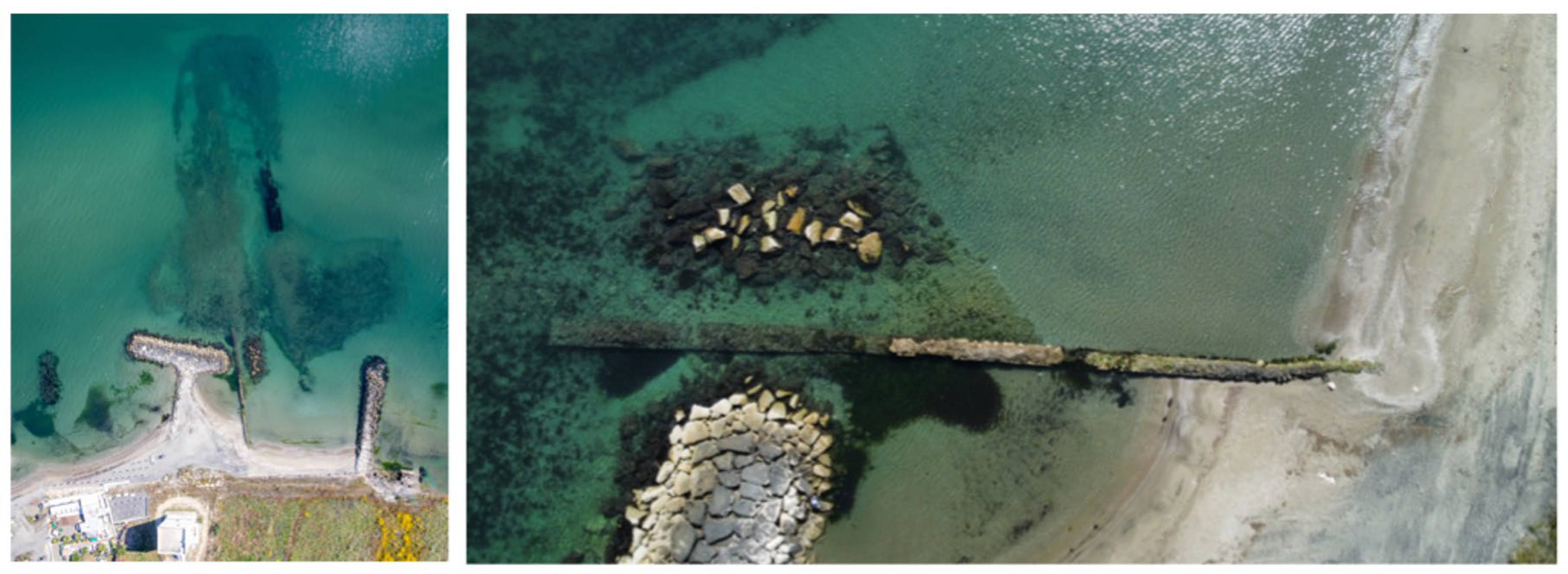
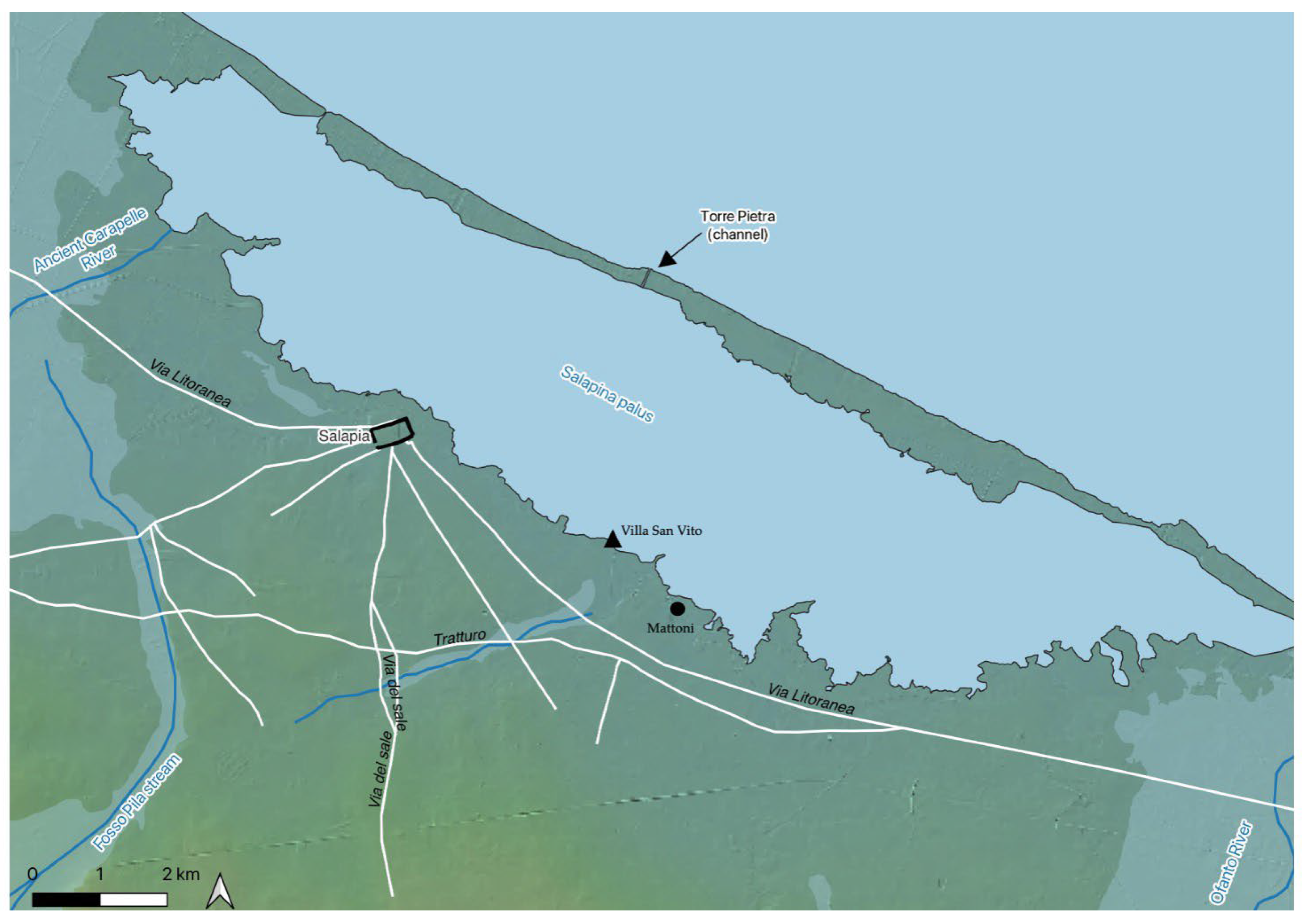
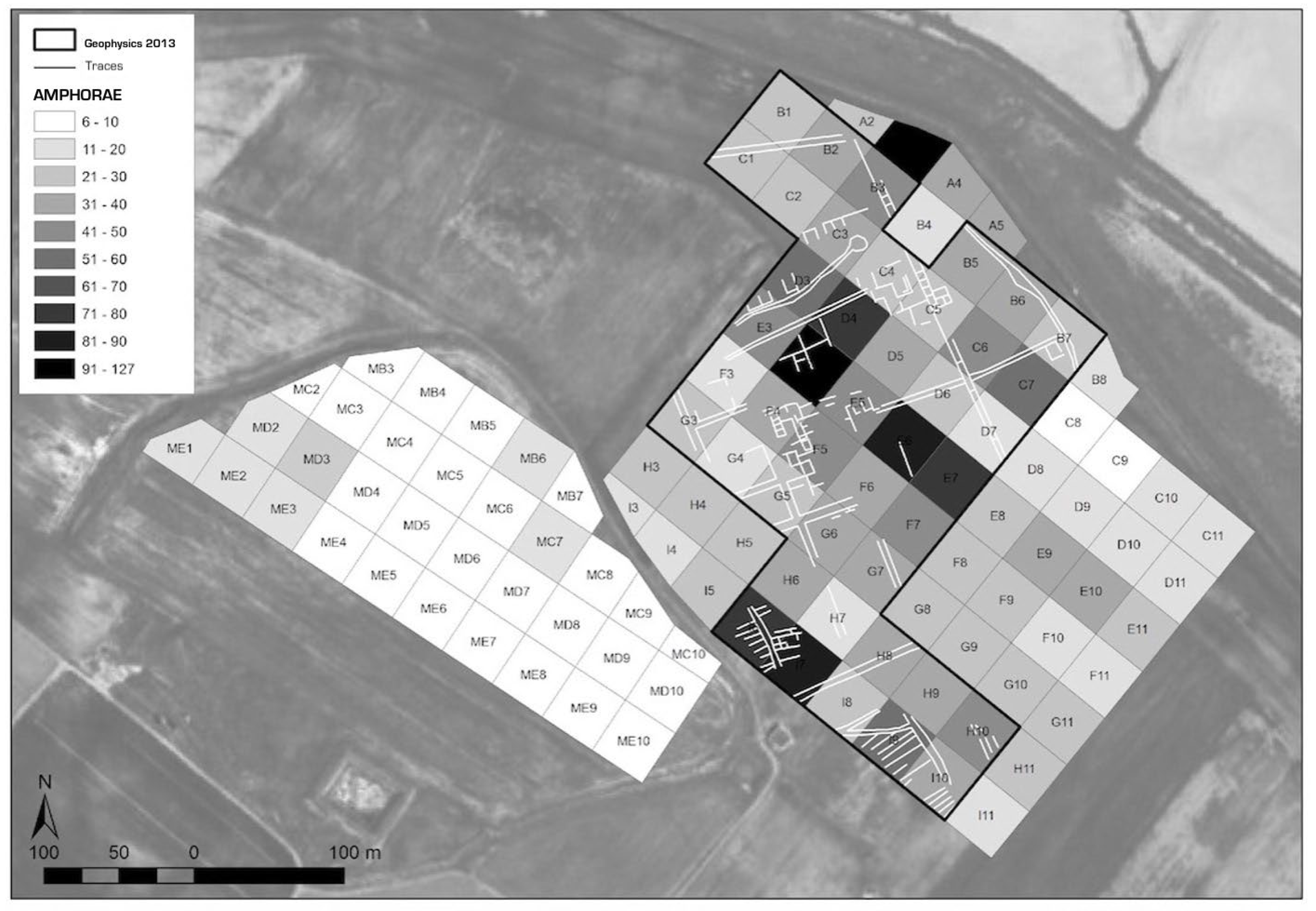
Disclaimer/Publisher’s Note: The statements, opinions and data contained in all publications are solely those of the individual author(s) and contributor(s) and not of MDPI and/or the editor(s). MDPI and/or the editor(s) disclaim responsibility for any injury to people or property resulting from any ideas, methods, instructions or products referred to in the content. |
© 2024 by the authors. Licensee MDPI, Basel, Switzerland. This article is an open access article distributed under the terms and conditions of the Creative Commons Attribution (CC BY) license (https://creativecommons.org/licenses/by/4.0/).
Share and Cite
Goffredo, R.; Totten, D.M. Building Resilience through Territorial Planning: Water Management Infrastructure and Settlement Design in the Coastal Wetlands of Northern Apulia (Salpia vetus-Salapia) from the Hellenistic Period to Late Antiquity. Land 2024, 13, 1550. https://doi.org/10.3390/land13101550
Goffredo R, Totten DM. Building Resilience through Territorial Planning: Water Management Infrastructure and Settlement Design in the Coastal Wetlands of Northern Apulia (Salpia vetus-Salapia) from the Hellenistic Period to Late Antiquity. Land. 2024; 13(10):1550. https://doi.org/10.3390/land13101550
Chicago/Turabian StyleGoffredo, Roberto, and Darian Marie Totten. 2024. "Building Resilience through Territorial Planning: Water Management Infrastructure and Settlement Design in the Coastal Wetlands of Northern Apulia (Salpia vetus-Salapia) from the Hellenistic Period to Late Antiquity" Land 13, no. 10: 1550. https://doi.org/10.3390/land13101550
APA StyleGoffredo, R., & Totten, D. M. (2024). Building Resilience through Territorial Planning: Water Management Infrastructure and Settlement Design in the Coastal Wetlands of Northern Apulia (Salpia vetus-Salapia) from the Hellenistic Period to Late Antiquity. Land, 13(10), 1550. https://doi.org/10.3390/land13101550






